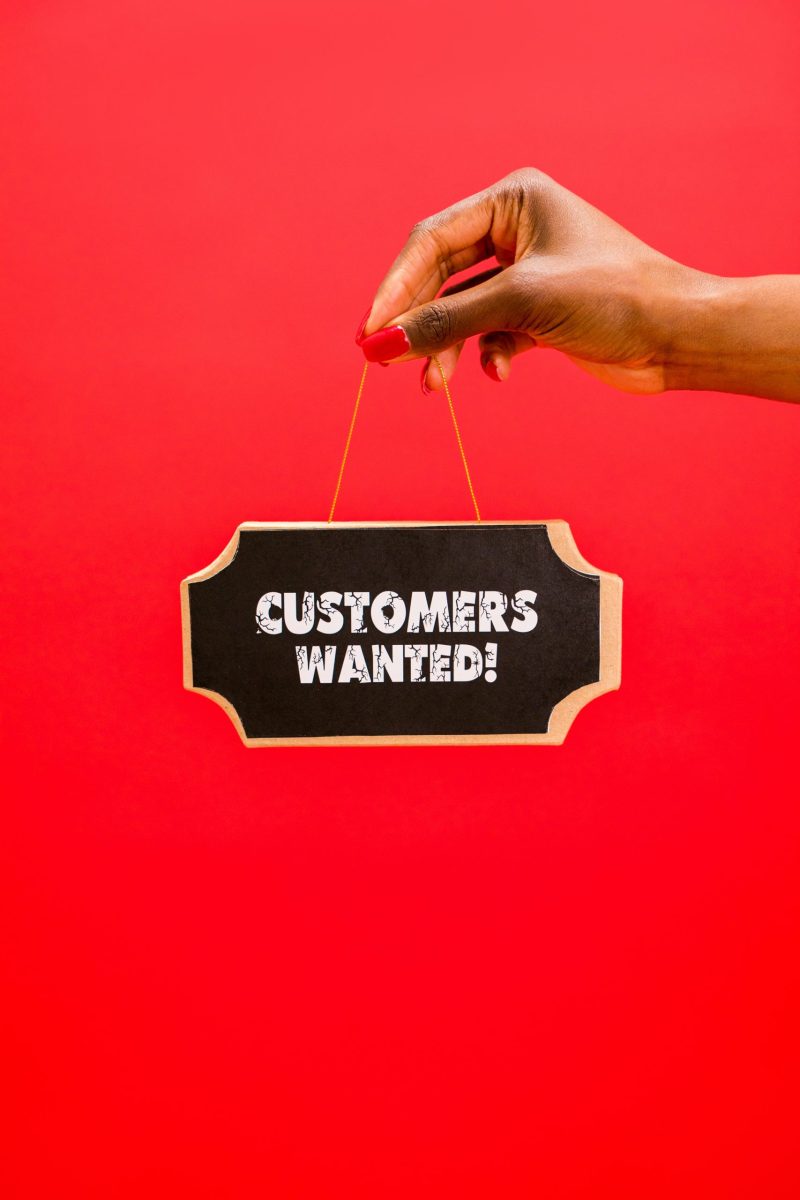☰
- Home
-
Solutions
Transformative solutions we deliver
- Carfax
- GoCRM
- Integrations
- About Us
- Contact Us
- Let's Connect
- Home
- Solutions
- Carfax
- GoCRM
- Integrations
- About Us
- Contact Us

Learn how to differentiate between keywords used in PPC and organic SEO strategies.
Your digital content’s keywords are an essential component that you should constantly and carefully analyze. In this post, we discuss the distinction between branded and non-branded keywords, when to use each type of phrase in your content, and how they might work in tandem.
What do keywords mean?
First things first: what are keywords, exactly? In other words, keywords are terms that are “key” to emphasizing what you want to discuss, whether it’s content about your company, the goods, and services you provide, or timely news stories pertaining to your brand.
In addition to being single words, keywords can also be phrases and are frequently referred to as “search terms.” This is because keywords are also referred to as “search queries” because they relate to the topics that people look for on search engines like Google.
Keywords are crucial for any company with a digital presence since they help you connect your brand with online users’ searches. As a result, in order to have a significant impact on Google, you should have a clear keyword strategy in order to have the best chance of ranking in a crowded field.
If you want to incorporate SEO (Search Engine Optimization) and paid advertising into your marketing strategies, keyword research will provide you with a solid place to start. Keyword research is a vital component of the content on your website. Keywords are what link your content with readers if you write blogs.
various keywords
One of two groups can be used to classify keywords:
Short keywords—these are limited to only one or two words (terms), like “car” or “electric car”—are an example.
Long-tail keywords are those that usually include three or more words and appear to be sentences or phrases, such as “family-friendly car with seven seats.”
Keyword use for organic SEO
The goal of organic keywords, which are those used through SEO, is to draw consumers to a website without having to pay for advertising. When implemented correctly, keywords in organic SEO can effectively draw in customers looking for comparable products or services. This sets the standard for what can be accomplished organically and is referred to as “free traffic.”
Writing blogs and articles, changing website copy, and optimizing metadata (the title tags and descriptions on each of your web pages) are all excellent ways to produce keywords through organic SEO.
PPC keyword usage
Keywords that are used in PPC (Pay-Per-Click) campaigns, a type of sponsored advertising, are at the other extreme of the spectrum. In an effort to rank for those search terms and enhance online visibility and website traffic, specific keywords related to your business are found. Keywords can be “bid” on, just like in an auction, in order to outrank rivals in the market and show up at the top of Search Engine Results Pages (SERPs).
As the two primary categories of PPC-based keywords, branded and non-branded keywords, come into play here. Below, we go into greater detail regarding this.
What distinguishes branded keywords from non-branded keywords?
PPC advertising is the go-to option for companies wanting to drive traffic right away, whether it’s to gather leads or make a sale directly online. It might be seen as a quick gain for companies with significant product or stock turnover. The distinction between branded and non-branded keywords is described here:
What do brand keywords mean?
Branded keywords are words or phrases that contain the name of your company (brand). These are fantastic for drawing in clients who are already familiar with your company or the goods you provide. The branded keywords we may use, for instance, are “SimpSocial websites.”
Non-branded keywords: what are they?
Non-branded keywords are ones that don’t contain the name of your company (brand), as you could have guessed. Instead, these are employed to interact with prospective clients who are unaware of your offerings or who are unfamiliar with the services you offer. For instance, “websites for car dealers” would be a non-branded keyword we could utilize.
How to combine branded and non-branded keywords
Contrary to popular belief, these can be used together. In reality, as part of a larger search strategy or customized PPC campaign, branded and non-branded keywords can complement one another. It all comes down to finding a balance.
Establishing your company’s finest branded keywords is an excellent place to start because they may be simpler to rank for naturally. Once this tactic is established and you are beginning to see results, it is essential to implement an SEO strategy that includes non-branded terms while still preserving your branded keyword efforts.
From research through purchase, branded and non-branded keywords work together to influence various stages of the sales process. We delve a little deeper into how to do this below.
Which keywords to use: branded or non-branded
Now that you’ve chosen the appropriate branded and non-branded keywords, the hard work can start!
Use of trademarked keywords when
When you wish to do the following in PPC advertising, branded keywords are the perfect solution:
To build a reputation online and raise brand recognition
To boost online conversions while staying within a budget
To raise your Google Quality Score overall
Use of non-branded keywords when
If you want to succeed in these areas, non-branded keywords in PPC advertising are the way to go.
For the purpose of increasing website traffic
To draw in new clients
To draw attention to deals or reductions
Boost your keyword selections
At SimpSocial, we offer a variety of automotive marketing services to improve your online presence, in addition to building stunning websites for firms in the automotive sector. Our SEO specialists are adept at developing a keyword plan that works for your dealership.
Additionally, as part of paid media solutions, our marketing team may create focused PPC ads, and our creative content team can use blogs and on-page adjustments to supplement the organic keyword strategy. Contact us right away to talk about how we can help your business grow, and we’ll take care of all your needs.


A customer data platform is a piece of software that collects several data streams into a single, unified database to assist manage and organize customer data.
A customer data platform (CDP) can be used to aggregate and store all of the customer data that a business collects, whether it be through a point of sale (POS) or customer relationship management (CRM) system, a website, or social media interaction, an email or customer service communication, or any other channel.
Due to its ability to interface with a wide range of external sources and compile data from numerous touchpoints, CDP software is one of the most valuable digital tools available. It is able to create a durable, consolidated customer database that is accessible to the entire business by doing this and intelligently connecting the appropriate interactions and transactions with the appropriate customer profiles.
What function does a customer data platform serve?
It is helpful to look at some definitions from other sources in order to comprehend the function of a customer data platform.
The term “marketing technology” used by Gartner to define a CDP is “a marketing technology that unifies a company’s customer data from marketing and other channels to enable customer modeling and to optimize the timing and targeting of messages and offers.” This demonstrates how important it is to aggregate consumer data in order to target the appropriate audience with the appropriate promotions, adverts, and campaigns at the appropriate time.
“A CDP is an off-the-shelf solution bought from a third-party vendor, as opposed to being built internally.”
However, it goes beyond that. A CDP is described by the Customer Data Platform Institute as “a packaged piece of software that creates a persistent, unified customer database that is accessible to other systems.” A CDP is described as “packaged” if it was acquired from a third-party provider rather than being developed internally.
This is crucial because packaged software is typically made to integrate seamlessly without the help of IT and development teams. This significantly lowers the expense, risk, and downtime linked to custom solutions. Despite this, CDP solutions are still very scalable and made to interface with the rest of your tech stack. As a result, marketers are free to establish their own guidelines for data collecting, segmentation, and orchestration.
The CDP creates individual profiles for each customer and unites them in a single database by gathering consumer data from e-commerce platforms, email marketing, social media profiles and activity, websites, web forms, CRM, and transactional systems. Any department within your business can use these statistics and insights to guide its strategy.
The majority of the time, marketers use CDP solutions to deliver tailored messages based on the wants and preferences of the customer or to retarget interested customers with recurring ads to stay top-of-mind.
What advantages do consumer data systems offer?
Silos between teams, campaigns, and departments pose major issues, which are understood by all businesses. They obstruct collaboration, communication, and production. If marketers must base their decisions on data that is fragmented in several channels and is confusing, tainted, or incomplete, they may even impair the consumer experience.
A CDP is made to eliminate silos by centralizing all consumer data, combining distinctive profiles, and using the power of analytics to identify patterns and forecast behavior. This, therefore, produces fresh opportunities for upsells and cross-sells.
However, a consumer data platform accomplishes more than that. A CDP also offers insight into consumer sentiment by connecting interactions, conversations, and behaviors across a variety of channels, allowing your marketing teams to adopt a more tactical approach to forging, fostering, or mending a connection.
A CDP aids marketers in creating a more strategic image of their ideal customer so they may target potential clients and retarget existing clients. They can also assist you in accurately forecasting the actions of your target customer and adjusting your marketing strategies as necessary.
Why is a platform for client data important?
Customer data platforms are crucial because first-party data is what this technology primarily gathers.
An unaltered and unfiltered view of what customers are doing, saying, and purchasing can be obtained by directly analyzing website traffic, social media activity, and subscription data.
Too frequently, marketing teams must rely on third-party data, which is typically gathered through cookies and trackers and sold or shared between organizations, to guide their tactics. First-party data, in contrast to third-party data, is created exclusively by and used for the advantage of your consumers.
This pertains to compliance, another factor that makes having a consumer data platform crucial. Consumers have the right to see the personal information that businesses collect and keep, as well as the right to have that information “forgotten” or deleted, thanks to stringent data privacy laws like the General Data Protection Regulation (GDPR) and the California Consumer Privacy Act. When data is compartmentalized among many information repositories, it is very challenging to comply with that; nevertheless, a CDP makes it straightforward.
CDP solutions may streamline both your marketing initiatives and your data compliance by setting up your firm to have organized, transparent, and aggregated customer data.
What are some of a consumer data platform’s important characteristics?
All CDP systems must comply with the following four requirements, according to the Customer Data Platform Institute:
The ability to accept real-time data from any source is the first requirement.
Second, they must record every single aspect of the data that has been ingested.
Third, they must enable unlimited (and legal) data storage.
The fourth requirement is that they be able to share data with systems that need it.
Vendor-neutral solutions are available on the majority of top platforms, allowing connectivity to and from any external systems. Additionally, they possess the complex data management skills necessary to combine organized and unstructured client data by comparing IDs in different systems.
The greatest CDP systems, above all, are simple to use for marketing teams and other business units. A well-designed CDP doesn’t necessitate complicated IT or data science involvement, making it simple for teams to carry out strategic campaigns from beginning to end, even though additional resources may still be required for some of the more advanced functions.

The good news is that the best ideas aren’t usually the most difficult to put into practice, which is helpful if your dealership wants to enhance its client retention strategy. Even if you’d like to, it’s nearly impossible to keep every single customer who walks through your door. And some of those individuals—llet’s face it—just make things difficult for your team.
What would it matter if you had a group of devoted clients that treated you like an old friend and routinely came back for service? Most likely, you already do, and these contented clients are among your biggest assets.
In addition to being the first to recommend you to their friends and family, loyal clients are also easier to keep returning to (for things they may not have previously thought to obtain from you). We must not disregard this.
In order to assist you concentrate on developing your business through your greatest clients, this post presents a helpful lens to look at your business decisions and uses significant industry figures from a SimpSocial study.
Making Use of the Pareto Principle to Reduce Time and Profit Losses
The Pareto Principle is an effective generalization that simplifies a lot of business decisions. The Pareto Principle, also referred to as the 80-20 rule, holds that 20% of all causes (or inputs) lead to 80% of all outcomes (or outputs).
The fundamental notion is that the majority of your results come from a relatively small portion of your efforts, and the rest of your efforts have a relatively tiny impact. Of course, it’s not an exact science.
You may see some good illustrations of the 80-20 rule at a dealership. For instance, according to the National Automobile Dealers Association, the new-vehicle department of a car dealership typically accounts for around 58% of a dealership’s total sales but less than 26% of a dealership’s overall gross profit. The service division accounts for 25% of profits while contributing less than half of those sales.
What does this entail for auto dealers, then? How would you put this concept into practice? The first step is to concentrate on the proper clients.
A Smaller But Lucrative Group: Quietly Content Clients
Not all of your most important clients purchased your services at the highest margins. The consumers who frequent your dealership year after year are your most valuable ones.
How can you improve your overall retention and make the most of the people you already have? You probably already know the answer to this.
How to Make Loyalty a Growth Driver
As part of our Dealership Service Retention Report, we investigated industry retention trends and discovered some compelling data. To begin with, 25% of clients who described themselves as “extremely loyal” to their servicing dealership indicated that “nothing” would cause them to think about going somewhere else. However, nearly half of the respondents stated they would think about leaving if they had a negative dealership experience.
What can we infer from this? It demonstrates that dealerships should focus more on satisfying those customers who return than trying to win over those who gripe about things like prices all the time.
This can be challenging because repeat customers are frequently the ones who don’t cause a scene. They aren’t the ones yelling on Yelp or calling the dealership to complain; therefore, they aren’t clamoring for your attention.
Establish a mechanism to monitor consumer visits.
We won’t dwell on this as most dealerships already have it, but before moving on to the next section, you’ll need a trustworthy technique to monitor your business. Gather each customer’s phone number and email address, and be sure to link that data to their previous purchases. A good system will enable you to rapidly identify the data on the clients who return the most often by sorting through your database.
It will be much simpler for you to identify which clients will value a memorable experience when you use this data to your advantage. Additionally, it offers a simple method for getting in touch with clients and creating a feedback loop.
Improve work quality to increase total client loyalty.
You need to run a company that is worthwhile for individuals to refer customers to if you want to increase referral revenue. Of course, this is painfully obvious: “If you want to be more profitable, become a better business.” However, you should consider this more in terms of priority.
In the aforementioned survey, we asked participants to rank six characteristics in terms of significance when choosing a repair shop for their vehicle. The best results were in the areas of job quality, price, and customer service quality. The second most significant consideration for individuals who indicated they are “extremely loyal” to the dealership where they service their vehicle was the level of customer service provided, which surpassed price.
Perhaps you’re thinking about reducing the price of some of your services to boost margins. Maybe you analyzed the advantages and disadvantages and determined that your decision wouldn’t significantly lower your level of productivity. However, over time, you’ll see a percentage of clients decide your services are “just not quite good enough” anymore, even though this may increase your income in the near term.
They eventually cease making the extra trip just to use your service. Or when prices are raised to reflect increased costs, car owners conclude the less expensive choice offers a better deal. Even if they return frequently, they might not be as eager to recommend you to their friends and relatives.
In the automobile business, the strength of your work speaks for itself when it comes to retention.
convert devoted patrons into brand evangelists
As we’ve previously mentioned, repeat customers pay $167 for every $100 they spent in year one in year three. Additionally, acquiring a new customer is five times more expensive than maintaining an existing one. Clearly, spending time on retention is time well spent.
But even though getting new clients is expensive, having a base of devoted clients helps reduce the cost. When a potential customer has been referred to you by a reliable source, it is much easier to earn their business. Loyal customers are the most likely to make this recommendation.
Based on how many new clients your best customers refer to you, you might want to provide them with special prizes. This may be something straightforward, like a discount at their subsequent service visit, or something unique, like an added benefit (more on that later).
Utilize the services that are already in demand to enhance the experience for recurring consumers.
The 80/20 rule’s ability to help you concentrate on what is already most beneficial to your business is one of its many wonderful features. One of the important conclusions from our study was that vehicle owners prefer to obtain specific services from dealerships as opposed to other locations.
In general, oil changes, electrical problems, manufacturer-recommended maintenance, and unidentified problems (such as those caused by the Check Engine light) are considerably more frequently sought out at dealerships by car owners. These are going to be the most convincing things to talk about when determining which services you want to market the most (whether through advertising or referrals).
Nevertheless, car owners are less likely to return with problems with the brakes, tires, or batteries. This implies that it’s critical for service consultants to spot those problems when the client is already at the dealership. Make sure your clients are aware that your dealership can handle their tires in particular, as 90% of drivers who buy tires elsewhere never return for service. This is a significant retention weakness.
In addition to keeping customers from seeking those services elsewhere, proactive maintenance gives dealerships the chance to protect their clients from problems even before they arise. This assists in transforming your “somewhat loyal” clients into “extremely loyal” clients.
Deliver added value
By giving your top clients a great experience, such as by offering exclusive bonuses, you may increase their satisfaction quickly. Giving customers something more memorable than just a loyalty discount will accomplish this.
SimpSocial prospers in this market. With the help of SimpSocial, new-car dealerships may offer a special package of reimbursable advantages with each qualifying service visit. This distinguishes you from the competition and aids in building lasting relationships with your clients. Additionally, these advantages set you apart from other dealerships, giving your devoted clients an incentive to continue doing business with you and refer new consumers to you.
Future automobile buyers can be easily persuaded by these advantages, providing you with the opportunity to impress them with exceptional vehicle maintenance and unanticipated repairs. It gives you the ability to gain their trust so that your dealership will be the first place they think of when the time comes for them to purchase their next vehicle.

The Best Voice Options to Grow and Protect Your Company
Prior to the advent of cloud communications, phone service was essentially “one of everything.” For better or worse, you had a single source handling everything with minimal modification. Calls occasionally went through with static and occasionally not at all, but that was how it was.
There are many different providers available nowadays. You have the option of domestic, international, or toll-free outbound (“termination”) and/or inbound (“origination”) calling. For each, you can employ a different provider. You can utilize a platform like Twilio, Nexmo, or SignalWire to establish a platform and manage your calls, then plug in a carrier solution to send your dials (like SimpSocial) to get the best of both worlds since the range of capabilities can vary from one provider to the next and everything works together. (Ask for a demo. It only takes a few seconds to add.)
Even for those of us in the industry, all of the options are, well, bewildering! Inbound and outbound calls depend on whether you’re making or receiving them, right? Every phone number can place and receive calls, right? Why do I need more than 40 carriers, too?
Understanding the terms and how they differ will enable you to customize your calling package to best suit your corporate or SaaS organization while boosting your profits and competitiveness.
Several Important Calling Features
Clear, crisp calls that always connect are a high requirement, whether the majority of your company’s calling is inbound or outgoing or your software as a service incorporates voice communication features. These days, it’s an integral part of the customer experience. Call quality and deliverability, however, are influenced by the providers you select, the services they provide, how they are set up, and your geographic location (as well as the location of the other party on the call).
Not all service providers are created equal! Key characteristics include:
Gotta love automation! Intelligent Call Routing (ICR) When a provider utilizes software to find the most affordable path for your calls among various carriers, the process is known as ICR (also referred to as Least Cost Routing, or LCR, by others). Most suppliers provide some variation. Only SimpSocial employs machine learning to identify the most efficient and effective routes. If your business values scalability, you should at the very least use least cost routing. You want more intelligent call routing if the customer experience is crucial.
Redundancy is also known as the number of carriers a supplier employs. The size of the footprint (i.e., geographic coverage and number availability), pricing, and scalability, as well as call quality and deliverability, are the most crucial factors. For instance, SimpSocial employs almost 40 couriers. The recovery process after a disaster must include this. For further information, go here or to the chart below.
Disaster recovery: Depending on where you are, any number of your calls could be impacted if one of the carriers that transports them goes down. Many of them are affected if a big one fails. You’re in trouble if your provider only employs one carrier or uses their own. For a call center, even one hour of downtime can be financially unsustainable. The majority of all providers and carriers, fortunately, have systems in place to minimize these (often confidential information, but you can inquire). However, having more carrier options and actual (as opposed to virtual) data centers always lowers your risk.
* Footprint and Number Availability – A provider’s footprint is essentially its geographic coverage. For instance, SimpSocial covers the majority of North America, or 95% of the +1 area. This results in calls of higher quality coming from more locations, as well as more readily available numbers in those locations.
Control and openness: If a call center is a vital component of your organization, you should give this alternative significant consideration. Very few providers allow you to see how your calls are routed, let alone take control of those routes. Although SimpSocial automatically chooses the best and least expensive path for your calls, you have the choice to switch carriers in real time, enabling you to avoid interruptions practically immediately. Find out more here.
Additional Factors and Limitations
All networks are not created equally, just as not all providers are. ILECs and CLECs, virtual and internet vs. copper and landlines, proprietary networks, aggregators, and other terms will be frequently mentioned. Despite the fact that most of the material seems to be intended to confuse, it all revolves around network architecture, which is crucial since it determines the features that a provider can offer, how much they will cost and the likelihood of an outage.
A single carrier provider has total control over their network, but also assumes all of the overhead and probably has a smaller calling footprint; obviously, there is no redundancy and fewer disaster recovery options. An aggregator uses multiple carriers, which decreases overhead but also lessens control and increases redundancy. They may or may not be willing to divulge which ones they use. The best of both worlds can be found via a Virtual Local Exchange Carrier, or VLEC (SimpSocial is one).
Which is best for your needs? Inquire about the network configuration and the benefits and drawbacks of each provider. You can also infer something from the features they offer. For instance, if they don’t have redundancy, they only offer one carrier.
Customer service, fraud prevention techniques like STIR-SHAKEN, and other features of cloud communications may also be crucial to your company. Although they are provided by all providers, the levels can differ. For impartial confirmation, you may also want to check out the provider evaluations on G2.com.
Inbound, Outbound, or Toll-Free Call Center?
Many businesses get many more calls than they make, while others primarily place calls. For example, a support center that answers questions takes orders, handles returns, etc., primarily needs inbound calling. If you want to make it easy for customers to call you – including calling for free – you want a toll-free service. If your company does telemarketing and cold calling for sales, chances are that outbound voice services will meet the majority of your needs. (And yes, technically any phone with inbound or outbound calling can do the reverse; the numbers still work both ways.)
The category that best describes your company, along with your budget and risk tolerance, will help determine the features you need and what you should look for in a provider. You might need both inbound and outbound services and prefer to deal with a single provider. (The good news is, unlike some areas of life, there isn’t a direct correlation between cost and quality; you don’t need to pay an arm and a leg for great service!)
Although choosing the right provider for outbound is important for call quality and deliverability, it’s easier than inbound. There are more to choose from, selecting phone numbers is mostly irrelevant, and it’s super easy to switch from one provider to another (of course you’ll still want to ask them about redundancy, disaster recovery, etc.).
Toll-free voice utilizes fewer carriers, and you’ll need to get a phone number(s), which can be tricky if you want your number branded (for example, 1-800-FLOWERS), but it’s still easier than “local” inbound because of the way toll-free numbers are administered on a national basis. For similar reasons, it’s relatively easy for a provider to offer toll-free redundancy if they utilize multiple carriers and are configured to support it. (SimpSocial offers toll-free transparency and control to the customer.)
Inbound is the most complicated, with the least number of major carriers and a great deal of complexity around acquiring phone numbers because they have to be “locally” obtained from a bazillion different sources. Providers with a small footprint can take a lot longer to acquire customers. As you might guess, having so many sources also complicates redundancy, which is not only moving a number between carriers but also essentially moving a number from one source to another. Last but not least, while outbound providers can be changed in a matter of minutes, inbound voice takes some work to set up when you switch.
For these reasons, if inbound calling is a core part of your business, you’ll want a provider who handles a lot of inbound traffic, has a large footprint, and has a network specifically set up to handle inbound redundancy. (To learn more about how SimpSocial handles inbound calling, register for our webinar on June 23, 2022!)
* * * * *
Bottom line: You don’t have to know every acronym in telecommunications or understand the ins and outs of how a provider’s network can be configured. But, you do need to know the importance of inbound vs. outbound voice traffic, whether having a toll-free number makes sense, and how critical calling is to your organization. If losing even an hour or two of business could cause major damage to your profit margin or your bottom line, then you need to know the basics described above and choose your providers carefully.

Want some ideas for quick responses to internet vehicle leads? You won’t let any leads lapse if you use these simple email responses for auto sales.
Imagine a regular workday at your auto business. How does it feel? As a salesperson, you probably do test drives, close sales, prospect, follow up with leads, and place calls. Your day is undoubtedly crammed with unexpected surprises if you’re not the sort to lounge around all day scrolling through Facebook (and you’re not, right?).
Given everything said above, how long do you typically take after receiving an email to reply to it? Who do you tend to?
If you have a lot of other things going on, let the email rest for a while instead of responding to it right away.
You’re undoubtedly letting leads slide through your fingers all day if your auto sales email responses aren’t going out in under 20 minutes. In today’s world, if a website visitor contacts you, they anticipate that you will be available instantly to address their query. They will go on to the next dealership that responds if you don’t respond to them very quickly.
Dealers observed by mystery shoppers answered half of their consumer inquiries within 30 minutes, according to the 2016 Pied Piper PSI Internet Lead Effectiveness Benchmarking Study. One out of every eleven customers did not get a response of any kind within 24 hours.
Even when a thousand other things are going on at once, be the dealership renowned for its lightning-fast email responses to auto sales inquiries.
Five things to keep in mind while responding to online vehicle leads
There are a few important factors to keep in mind when responding to leads.
Respond in a prompt and courteous manner.
Make your responses unique.
Have an after-hours strategy in place so you can guarantee rapid service to every consumer.
Regularly follow up with leads, and make it simple for them to get in touch with you
Manage your leads and progress.
10 email replies for vehicle sales when you need to respond quickly
Using email templates through your CRM is a great way to interact when you’re not extremely busy and have time to reply to emails and nurture prospects. You can be confident that you are stating everything that has to be said and that the template has already been proofread and is mistake-free.
But when else? To personalize an email template, you don’t even have a minute. Because you’re so busy and have only two choices, vehicle sales email responses occasionally have to be succinct and to the point.
Send a succinct email response to the consumer right away.
Delay the email too long, and you risk losing the client.
This is the time to prepare and have a few ready-made email responses for auto sales that are short and professional but also simple to recall. What is most crucial? Your return email should always begin with “Dear [Name].” Even if you’re in a hurry, personalization should never be compromised for efficiency.
1. The kind of client email: an inquiry about a car’s price
“Thanks for your email, Andy,” was your email reply. We make a concerted effort to price our automobiles fairly, but in the end, it depends on how happy our clients are with a vehicle’s actual condition. Do you mind if I give you a test drive? To make an appointment, call me at XXX-XXX-XXXX.
2. Emails from clients inquiring about the availability of a particular vehicle
It’s fantastic to hear from you, Jillian; you replied in your email. On our property right now, the Honda CR-V you’re considering taking a test drive in is. Call me at XXX-XXX-XXXX, and I’ll schedule an appointment for you.
3. Emails from clients who are unsure about whether their credit is good enough to purchase a car.
Your email reply: “We appreciate you getting in touch, Jessica. I’ve assisted numerous customers in obtaining finance; however, owing to the delicate nature of the subject, I would rather discuss credit in person than by email. We can arrange a time for you to come in and hear about your alternatives if you call me at XXX-XXX-XXXX.
4. The kind of client email: There are numerous issues that need investigation and comprehensive answers.
Your email answer: If you simply don’t have the time to respond to the email right away, it could be better for you to ask a coworker if they can. Losing a prospective sale is disappointing, but if a colleague salesperson can act fast and close the deal, it helps the dealership as a whole. Do not ignore email prospects just because you lack the time to respond.
Any of these email responses for auto sales can be modified to reflect your distinct style; you want to convey your point clearly without sounding overly formulaic. Even on the busiest of days, personality and customer service are crucial. Each email you send should, of course, have a Call To Action (CTA) that nudges the reader to take action. If you’re simply going to send a brief email, those few sentences should persuade the reader to call you and arrange a meeting for a test drive.
5. The kind of client email: asking about the worth of their existing vehicle as a trade-in
Your email reply: “Good day, Derek. We appreciate your desire to trade in your present car. We certainly offer fair trade-in values, but for a more accurate estimate, it’s best to bring the car in for an assessment. Could you please provide me with a time? Reach me at XXX-XXX-XXXX.”
Email subject line: Interested in leasing possibilities?
Your email reply reads, “Hello, Susan. Leasing is a great choice for many people, and we have various options to suit different needs. To discuss more about these options, let’s meet in person. Can I make you an appointment? Give me a call at XXX-XXX-XXXX.”
7. Type of customer email: Wants more details on a vehicle’s features
Your email response: “Hello, Bob. The vehicle you’re interested in comes with a host of features. However, I think it would be best if you experienced these firsthand during a test drive. Can I schedule one for you? My number is XXX-XXX-XXXX.”
8. Type of customer email: Inquiring about warranty information
Your email response: “Hi, Linda. Thanks for asking about warranty information. Our dealership offers comprehensive warranties, but to go into specifics, it would be best if we could talk this over in person. Give me a call at XXX-XXX-XXXX to set up a time that works for you.”
9. Type of customer email: Asking about the dealership’s hours and location
Your email response: “Hello, Jake. Our dealership is conveniently located at [address], and we are open during [hours]. Would you like me to set up an appointment for you to come in and browse our inventory? Call me at XXX-XXX-XXXX.”
10. Type of customer email: Interested in financing options
Your email response: “Hi, Karen. I appreciate your interest in our financing options. It would be best to discuss these details in person due to their complexity. Please call me at XXX-XXX-XXXX to arrange a time to meet.”

Are you prepared to increase hybrid and all-electric vehicle sales? With assistance from SimpSocial, get your sales staff ready to answer these EV battery FAQs!
Because they supply the gadget with electricity, batteries are an essential part of many electronic devices. The majority of gadgets couldn’t operate without a battery. The development of electric vehicles (EVs) is a prime example of how batteries are no longer just used in small electrical devices.
EV batteries, as opposed to conventional automotive batteries, are made to store and discharge enormous amounts of electricity. This is required for an EV to operate properly. Additionally, EV batteries are made to last longer than conventional automobile batteries. An electric vehicle (EV) battery can endure for many years with good care and maintenance without requiring significant upkeep or replacement. Few individuals, however, are fully aware of how EV batteries operate, which has remained a hurdle to EV adoption in the retail vehicle sector. In order for dealers to be ready to respond to them when selling electric vehicles to interested clients, we will address a few of the most frequently asked topics today. Move along!
What Kinds of Batteries Are Available, Number One?
For EVs, a variety of battery types are available. These consist of:
Battery Types: Lithium-Ion
The most typical battery used in EVs is a lithium-ion battery. They have a high energy density, which allows them to store a lot of energy in a small area and function well for a long time. Lithium-ion batteries can overheat if not used properly, and they are also expensive to make.
Lithium-Ion Batteries
The earliest type of EV battery still used in some cars today is the lead-acid battery. They are generally inexpensive to make, despite having a low energy density. In order to maintain their effectiveness over time, lead-acid batteries also have a tendency to degrade quickly.
Batteries with nickel-metal hydride
Lithium-ion batteries have essentially taken the place of nickel-metal hydride batteries in EVs, which were once the norm. They can survive for several years before needing to be changed, and they have a medium energy density. They can cost more than other available battery kinds, and they are not as effective as lithium-ion batteries.
Ultracapacitors
A more recent type of battery that is swiftly gaining appeal in the EV market is the ultracapacitor. They may be drained and recharged numerous times without losing performance thanks to their extremely high energy density. They are also quite effective and don’t need to be changed for many years.
How long can an electric vehicle’s battery last?
The battery life of an electric car is affected by a number of variables, including the vehicle’s type and model, the battery, its age, how it is used, and how it is maintained. Typically, the battery life of an electric car is 8 to 10 years. However, given that some batteries have a lifespan of 15 years or longer, automobile buyers feel much more confident about making the investment in a car with electric battery components.
Keep an EV battery fully charged and use it frequently to extend its lifespan. Don’t let the battery run entirely flat. Replace your battery as soon as possible if it starts to exhibit indications of deterioration, such as decreased performance or capacity. Additionally, you need to thoroughly clean and maintain the connectors and battery casing.
As with any other vehicle component that needs routine inspection and repair, your service team will be able to provide customers with all essential advice during service appointments and will be knowledgeable about how to maintain EV batteries. Remind your customer that your technicians are qualified to maintain all parts of their vehicle, including any electronic ones, if they are concerned about battery maintenance.
#3: How Should an EV Battery Be Thrown Away?
Oh, here comes a difficult query! There are correct ways to dispose of an EV battery, just as there are alternatives to simply throwing a battery in the trash. These consist of:
Pyrometallurgy
The technique of heating a substance until it melts and can be poured out is more popularly known as smelting. Metals from used batteries and other items are frequently recycled using this method.
Hydrometallurgy
Water is used in the hydrometallurgy process to dissolve materials. This can recycle some lead-, copper-, and other metal-containing batteries. The dissolved metals can then be recovered and recycled from the water.
Actual Recycling
Sometimes disassembling a battery into its individual parts and reusing them is the best method to recycle it. By disassembling the battery and recycling each component, this is accomplished.
Rapid fire: Increase Electric Vehicle Sales at Your Auto Dealership Creative Concepts
Are you prepared to increase hybrid and all-electric vehicle sales at your dealership? Here are some straightforward suggestions for making EVs more approachable to your clients who could still be on the fence about utilizing green vehicle technology:
Make an FAQ area for electric vehicle questions on your website. Make it easy to find, and think about printing it out to hand out to buyers as they peruse the cars on your lot.
Ensure that your sales team is completely familiar with these FAQs.
Look into the specific discounts and deals that your province is offering. The savings may be sizable and could influence many customers’ decisions.
Assure your clients that your sales and service staff can address any inquiries they may have regarding hybrid and electric vehicles. They will never be left in the dark.
Learn about the advantages of electric car technology for the environment. According to a recent study, the two largest consumer groups (Millennials and Gen Z) share the value of environmental stewardship.
Make green automotive technology a selling point for your dealership. Turn your dealership green! Bring in more hybrid vehicles than gasoline-powered ones. Count on them to sell.
Final Reflections
In a nutshell, electric car batteries are utilized to power them. They exist in a range of sizes and forms to accommodate the power requirements of various vehicles, from small commuter cars to large trucks and are rechargeable (often recharging while the car is being driven, called “regenerative recharging”).
Even though EV batteries are frequently pricey, they have many advantages that make the cost justifiable. Because of this, many hybrids and completely electric cars have higher beginning expenses, but over time, the costs of maintaining the car drop dramatically. Customers who invest in the purchase of an electric car can greatly benefit from it, including long-term savings and environmental benefits. The majority of provinces also provide significant refunds for such investments.
SimpSocial can assist you if you’re seeking a digital marketing firm for auto dealers. We create solutions because we recognize that a vehicle dealership is a specialized industry and that you need to make sure that potential customers see you and your offerings. To help you achieve your goal of selling more cars, we have innovative alternatives. Visit our website right away to schedule a free consultation and see more information about our digital services, success stories, and free dealer education materials.

AI in the workplace can be difficult to sell due to concerns that it would result in less skilled workers, depersonalize the purchasing experience, or perhaps completely replace real-world people. Even though you may not yet be a fan of AI, your dealership’s consumers appear to like how it enhances their buying experience.
The automotive sector is currently experiencing a paradigm shift in how companies conduct business and interact with customers in today’s fast-paced digital environment. The emergence of AI technologies, including chatbots, task automation, and predictive analytics, has fundamentally changed how dealerships do their everyday business. AI enables dealerships to optimize their operations, concentrate on customer service, and eventually increase sales by automating monotonous jobs and providing improved customer support.
Whether you’re a believer or a skeptic, we’re here to guide you through the fascinating world of artificial intelligence so you can learn how it can make your dealership successful in the modern era of technology.
Growing Use of Chatbots
You’ve come to the right place if you’re curious about what these little talking robots actually are and how they operate. A chatbot’s principal objective is to mimic real human interaction by using high-tech artificial intelligence tools to understand and reply to consumers. In essence, they’re designed to give consumers the impression that they’re speaking to a real person (cool, huh?). Customer service, question-answering, task assistance, and casual chatting are all things that chatbots can be used for. By responding quickly to consumers’ questions or requests, they can be found in messaging applications, websites, or specialized platforms, and they strive to automate and streamline communication operations.
It’s obvious that chatbots—even in the automotive industry—have become an essential tool for automating and improving customer support. Dealerships are now able to offer round-the-clock support, rapid inquiries, and individualized assistance thanks to these AI-powered virtual assistants. Chatbots can comprehend and reply to consumer inquiries by utilizing natural language processing (NLP) skills, providing a seamless online experience. Chatbots can respond to a variety of questions, such as those on cost, availability, and financing, in a matter of seconds. Chatbots increase customer happiness, establish confidence, and guarantee that potential leads are interested and engaged by providing timely responses and pertinent information.
Chatbots with AI capabilities are also excellent at qualifying and generating leads. Chatbots can display vehicles that are a good fit for the customer’s needs by displaying customized suggestions and automatically gathering consumer information and preferences. These interactions aid in the identification of prospective customers and allow dealerships to concentrate their efforts only on qualifying leads. You can significantly speed up the conversion process by focusing on these lucrative leads.
Quick Tip: We advise utilizing a chatbot that offers a tailored experience to enhance the impact of chatbots in your dealership’s advertising. Use a chatbot that can remember the customer’s name, preferences, and past discussions in addition to being able to respond to them by name. By doing this, the chatbot will be able to offer customers who return a more personalized experience and recommendations based on their prior encounters.
The Effectiveness of Automated Tasks
Not everything AI can do is create a groundbreaking chatbot. In dealership operations, task automation reduces manual labor, minimizes errors, makes the best use of resources, and increases productivity. Your dealership may increase productivity, streamline procedures, and devote more time and resources to what really matters—customer service and satisfaction—by utilizing AI technologies to automate repetitive operations.
Using task automation, a dealership can accomplish the following objectives:
* Inventory management—AI innovations like machine learning algorithms make it possible to estimate demand accurately, set the best prices, and manage inventory effectively. Dealerships may ensure the appropriate vehicles are available at the appropriate time, lowering carrying costs and increasing turns, by automating these operations.
* Marketing initiatives that are specifically targeted can be produced using AI-powered systems that examine consumer information, preferences, and online activity. Your dealership may maximize its advertising budget and target the most appropriate audiences by automating the process of identifying potential buyers and customizing ads accordingly.
* Inventory Advertising Integrations: For quick and simple ad generation, task automation can deliver your real-time inventory data to advertising platforms. This makes sure that ads are only shown for vehicles that are in stock and on the market. Your inventory data can be synchronized with social media sites like Facebook using automated methods. This type of link can cause advertisements to pause or display in response to changes in supply levels, effectively reducing wasted advertising expenditure on vehicles that are momentarily out of stock.
Quick Tip: It’s usually preferable to start with simple, repetitive jobs when integrating task automation into your dealership’s operations. A large amount of time should be spent on relatively simple and repetitive jobs; therefore, identify those. These duties could involve data entry, creating reports, or sending follow-up emails. Your staff can save time by automating these tasks, which they can then use for higher-value duties.
Keep in mind that task automation is a journey, and it’s crucial to regularly assess and improve your automation plan as you spot new opportunities for improvement. Your dealership can uncover considerable time and resource savings by starting small and steadily expanding automation efforts, ultimately increasing overall efficiency and production.
Predictive Analytics’ Power
Predictive analytics has a huge potential to revolutionize dealership operations when powered by AI. Predictive analytics algorithms can offer insightful forecasts by utilizing historical data, market trends, and consumer behavior patterns. This enables your dealership to make defensible decisions based on reliable, actionable facts. Predictive analytics can help your dealership efficiently address client requests and stay ahead of the competition in a crowded industry.
Predictive analytics may help dealerships with a variety of objectives, including:
* Sales forecasting—Predictive analytics algorithms can produce precise sales estimates for various vehicle models, regions, or time periods by examining a range of data sources, including customer demographics, historical sales performance, economic indicators, and market trends. The risk of overstocking or passing up sales opportunities is reduced thanks to the use of this information by your dealership, as it helps it organize its inventory, marketing initiatives, and sales strategies more efficiently.
* Pricing tactics that work best Competitive automobile pricing is essential. In order to suggest the best price strategies, predictive analytics can examine market conditions, competitive pricing, and client preferences. Your dealership can choose the appropriate pricing thresholds to maximize revenue while still appealing to potential customers by understanding the relationship between price elasticity and demand. Systems for pricing optimization enabled by AI can also continuously track market trends and make competitive price adjustments in real time.
* Targeting and segmentation—By examining consumer information and behavior trends, AI systems may isolate several client groups according to their preferences, purchasing patterns, and likelihood to make a purchase. Because of this segmentation, dealerships are able to develop customized marketing campaigns, specialized incentives, and appealing offers for each segment. Your dealership may greatly increase marketing efficiency and boost conversion rates by focusing on the right customers and sending them the correct communications.
* Planning for service and maintenance: predictive analytics can examine information on vehicle performance, maintenance history, and other factors to determine when a vehicle may need repair or maintenance. By doing this, your dealership can better serve customers, plan maintenance appointments in advance, and reduce unforeseen problems.
Quick Tip: It’s crucial to keep in mind that models need to be continually improved and validated when applying predictive analytics to your dealership operations. Predictive models’ accuracy and potency can be impacted over time by shifting market conditions, client preferences, and other variables. Regularly review and update your predictive models based on fresh information and insights to achieve peak performance.
Bonus Advice: By contrasting your predictive models’ forecasts with actual results, you may verify their accuracy. Any gaps or potential improvement areas can be found using this. Investigate the underlying causes if there are any disparities, then make the necessary model adjustments. Predictive models can be improved and validated to help you make sure your decisions are data-driven and based on the most recent, accurate facts.
Because it enables dealerships to streamline operations, improve customer experiences, and increase sales, artificial intelligence has effectively changed the automotive advertising environment. Your dealership can concentrate on providing great customer service and developing long-term connections with customers by utilizing AI technologies and capabilities like chatbots, task automation, and predictive analytics. The significance of having reliable, usable data for your marketing initiatives only increases as this business develops. In addition to assisting you in collecting that data, technology like AI can also use it to benefit your dealership, ensuring that your consumers have a more tailored shopping experience than what your rivals can provide.

The little things in life may sometimes make getting through each day so much easier. One of those minor details is the ability to upload arriving and on-order units to your dealer website from SimpSocial’s Control Centre before they ever show up on the lot. Yes, even those without a VIN as of yet! We are aware that a few of our client partners, like our Toyota dealers, wait to get the VIN until the car actually shows up on their lot. Customers may find it difficult to reserve or pre-buy inventory as a result, and you may find it difficult to effectively anticipate your vehicle sales and obtain enough inventory from your OEM.
The little things in life may sometimes make getting through each day so much easier. One of those minor details is the ability to upload arriving and on-order units to your dealer website from SimpSocial’s Control Centre before they ever show up on the lot. Yes, even those without a VIN as of yet! We are aware that a few of our client partners, like our Toyota dealers, wait to get the VIN until the car actually shows up on their lot. Customers may find it difficult to reserve or pre-buy inventory as a result, and you may find it difficult to effectively anticipate your vehicle sales and obtain enough inventory from your OEM.
At every point of the ordering process, we want to ensure that our dealer partners can promote and sell all of their inventory. This functionality has been introduced so you can now enter these automobiles into the backend, add photographs if you’d like, finish filling out all of the required information about the vehicle, then upload that inventory to your website where customers can shop for them.
Additionally, as status indicators on your website, you can use words like “incoming,” “on order,” “reserved,” “pre-order,” and others. Since everyone appreciates transparency, you’ll see these as banners on the VDP and SRP, easily and efficiently informing your customers of the situation. Another method that we make things simpler! Find out how we can simplify the marketing for your dealership right now!
 Every year, Google holds Google Marketing Live, a conference for marketers that covers the most recent advancements in Google’s marketing tools and services. This year’s subject was relevant and simple to understand. While AI predominated the GML discussion tracks this year, a number of additional releases and improvements were also revealed.
Here is our summary of Google Marketing Live 2023’s most significant announcements and developments.
AI for conversation and Google Ads
Digital marketing has undergone a transformation thanks to AI, and Google Marketing Live 2023 emphasized how crucial this is to the automobile sector. Google unveiled cutting-edge AI-powered tools and solutions that streamline advertising campaigns, improve bidding tactics, and boost ad effectiveness. With Google AI-driven conversation, you can now even develop Google Ads campaigns right inside the Google Ads interface.
Dealerships can more efficiently allocate resources and increase the return on advertising spend by embracing automation.
Experiences with Personalized Ads
Personalization has emerged as a crucial component of marketing in a time when customers demand customized experiences. The need of providing potential automobile purchasers with individualized experiences was underlined at Google Marketing Live 2023. Google demonstrated its improved skills for precision targeting and personalization through search ads and YouTube ads. Throughout the buyer’s journey, automotive manufacturers may use these tools to distribute pertinent content, engage customers with customised offers, and forge deep connections.
Search and shopping adverts are combined in the Google Search Generative Experience.
Google Ads now offers two additional campaign types: Demand & Video Views Gen
Google Marketing Live 2023 highlighted the enormous potential of video advertising for the automotive industry as video content continues to rule online platforms. The event highlighted YouTube’s improved targeting, measurement, and creative optimization capabilities. Automotive companies can use video advertisements to attract audiences,
To increase conversions, demand generation campaigns will appear on YouTube Shorts, YouTube in-stream, YouTube in-feed, Discover, and Gmail. Additionally, a new lookalike segment builder will assist advertisers in reaching new audiences.
Consumer Trust and Privacy
Google Marketing Live 2023 emphasized the value of consumer trust and data protection in a time of rising privacy concerns. In order to provide relevant ad targeting while respecting users’ privacy preferences, Google released modifications relating to user privacy, such as the Federated Learning of Cohorts or FLoC (one of the standards in the Privacy Sandbox).
GML2023 insights came prepared with enabling advancements for the automotive industry, including tailored experiences, video advertising, and machine intelligence. Automotive firms can effectively engage their target audience and achieve sustainable development in the digital era by embracing the power of personalisation, automation, video advertising, and machine learning while preserving privacy and customer trust. If you have any inquiries, get in touch with a member of our team of digital marketers.
Every year, Google holds Google Marketing Live, a conference for marketers that covers the most recent advancements in Google’s marketing tools and services. This year’s subject was relevant and simple to understand. While AI predominated the GML discussion tracks this year, a number of additional releases and improvements were also revealed.
Here is our summary of Google Marketing Live 2023’s most significant announcements and developments.
AI for conversation and Google Ads
Digital marketing has undergone a transformation thanks to AI, and Google Marketing Live 2023 emphasized how crucial this is to the automobile sector. Google unveiled cutting-edge AI-powered tools and solutions that streamline advertising campaigns, improve bidding tactics, and boost ad effectiveness. With Google AI-driven conversation, you can now even develop Google Ads campaigns right inside the Google Ads interface.
Dealerships can more efficiently allocate resources and increase the return on advertising spend by embracing automation.
Experiences with Personalized Ads
Personalization has emerged as a crucial component of marketing in a time when customers demand customized experiences. The need of providing potential automobile purchasers with individualized experiences was underlined at Google Marketing Live 2023. Google demonstrated its improved skills for precision targeting and personalization through search ads and YouTube ads. Throughout the buyer’s journey, automotive manufacturers may use these tools to distribute pertinent content, engage customers with customised offers, and forge deep connections.
Search and shopping adverts are combined in the Google Search Generative Experience.
Google Ads now offers two additional campaign types: Demand & Video Views Gen
Google Marketing Live 2023 highlighted the enormous potential of video advertising for the automotive industry as video content continues to rule online platforms. The event highlighted YouTube’s improved targeting, measurement, and creative optimization capabilities. Automotive companies can use video advertisements to attract audiences,
To increase conversions, demand generation campaigns will appear on YouTube Shorts, YouTube in-stream, YouTube in-feed, Discover, and Gmail. Additionally, a new lookalike segment builder will assist advertisers in reaching new audiences.
Consumer Trust and Privacy
Google Marketing Live 2023 emphasized the value of consumer trust and data protection in a time of rising privacy concerns. In order to provide relevant ad targeting while respecting users’ privacy preferences, Google released modifications relating to user privacy, such as the Federated Learning of Cohorts or FLoC (one of the standards in the Privacy Sandbox).
GML2023 insights came prepared with enabling advancements for the automotive industry, including tailored experiences, video advertising, and machine intelligence. Automotive firms can effectively engage their target audience and achieve sustainable development in the digital era by embracing the power of personalisation, automation, video advertising, and machine learning while preserving privacy and customer trust. If you have any inquiries, get in touch with a member of our team of digital marketers. 
SimpSocial’s theme for the year was originally supposed to be growth, but it swiftly changed to adaptability and resilience. We had some of the greatest growth in our history in the first quarter and were fresh off a prosperous NADA conference. The orders to stay at home in North Carolina and the rest of the country then arrived in the middle of March. Suddenly, the year wasn’t about growth but survival, as 25% of our firm disappeared apparently overnight. Our first concern was making sure that everyone on our team was safe and healthy, so we swiftly closed our office and began working remotely. After converting to a remote workforce, we were able to concentrate on the well-being of our company as well as that of our clients and partners.
Although our leadership team wasn’t involved in making decisions during the 2009 financial crisis, we were unable to overlook the upcoming recession due to the hardships the previous recession caused us in our early professions and the lessons we learned in school. Since 2018, our company’s top objective has been to actively save and get SimpSocial ready for a potential economic crisis. We reduced wasteful spending, made costs more variable, invested in automation, saved money, and developed backup plans as we became leaner. At all costs, we wanted to avoid layoffs.
Although we believed we were well-prepared, we observed as the worst-case scenarios in our backup plans quickly came to pass over the course of two weeks. However, our team consistently demonstrated our company’s key principles of grit and elevating others, as everyone promptly made the necessary sacrifices. Our executive team took temporary pay cutbacks, our entire workforce postponed their usual rises in April, we increased workload owing to cost-cutting measures, and we communicated with one another more and offered support wherever we could. This team’s altruism enabled us to respond to requirements as they developed and helped us survive the crisis’s early unknowns.
We have incomparable gratitude for our customers and business partners. They stayed with us and had faith in the digital marketing efforts they were making despite shutdowns, inventory disruptions, COVID sickness, and risks to their own enterprises. Without the dedication of our clientele, we could not have progressed or endured this long. In order to reflect the new environment in which we found ourselves, our staff changed everything and worked harder than ever before for our clients. It never means more for us to maintain our dedication to unmatched customer service and results than when it might be more convenient to “take it easy.” Instead, we strengthened this commitment to our consumers, vowing to be there for them in times of need and devoting more resources to it.
As working from home grew a little more commonplace, racism and the ongoing struggle for social justice once again confronted our country. We started to ask ourselves some challenging questions as protests spread across the country, including in Raleigh, our hometown: “What could we be doing better?” “Where are our own biases?” and “How could we better contribute to a company culture of diversity and inclusion?” We vowed to our team that we would continue to work toward building a diverse and inclusive organization and seek to be a more uplifting force in our communities. Although we are aware that there is always more work to be done and that progress never happens overnight, we are committing to this for all time. We’ve made a number of investments so far this year, including:
Martin Luther King Jr. Day will be celebrated with an additional company holiday, bringing our total number of company holidays to 11.
We have broadened our scholarship and recruitment efforts in the state of North Carolina to include Shaw University, North Carolina State University, and UNC Wilmington, all of which can provide us with prospects from a variety of backgrounds.
invested in a committed human resources team to strengthen our HR procedures and add greater responsibility.
SimpSocial’s Culture Committee was established with an emphasis on the four pillars of involvement in the community, the SimpSocial community, alignment, and recognition.
facilitated access to learning opportunities for diversity and inclusion for our employees.
A webinar on mental health was delivered in collaboration with Modern Health.
Several individuals on our team received regular coaching and leadership development opportunities.
We were able to assess the damage done to us after the initial shock of pandemic shutdowns. We once again focused on the future and the investments we would need to make in order to remain strong in the years to come. We started to reinvest and take more risks rather than make judgments based on fear and the unknown. The following investments will sustain us for a very long time:
Zero layoffs to assist us in resuming operations as shutdowns started to lessen and business increased.
After the first delay, the entire workforce received raises.
creation of PRO Drive, a fixed operations tool, to help our clients’ service divisions succeed in marketing.
Our organization has made new hires in a number of its departments as an investment in future growth.
We are tremendously appreciative as the year’s finale draws near. We are appreciative of our wonderful team, our customers, our business partners, and our friends and family. Although we are stronger, more resilient, alert, compassionate, and sensitive as a result of 2022, we do not know when these trying times will end. Every challenge presents an opportunity. Because of this, this year, while we confronted challenges, our guiding principles of comfortable being uncomfortable and continuous improvement served as guidance.

Remote offices, national sales teams, international projects, mergers involving multiple states, centralized departments cut off from the main office, and outsourced duties: What do these corporate entities have in common? Of course, the requirement for employee “virtual teams”.
I’ve provided consulting services to numerous businesses that use various virtual team configurations in a variety of contexts. No matter where they are located or what kind of business they are in, they all suffer the same problems, which I have highlighted. I want to assist since I’ve heard how miserable these companies’ bosses and staff members are. Here are some suggestions to help your business lessen the tension and worry brought on by the adoption of the modern virtual team.
Let’s start by examining the most typical difficulties I’ve encountered:
People fail to comprehend “why”
In his book Start With Why, Simon Sinek cites research that shows decisions are made by the emotional component of the brain, not the logical or language-based parts. [blockquote-left]In person, we are far more effective at communicating our “why” because of our body language, passionate facial expressions, and tone of voice. Virtual teams frequently work on projects, tasks, objectives, or goals without truly knowing why they are doing it. These team members thus fail to grasp the “why” or become passionate about the work they are performing. This could result in a significant drop in production or, worse yet, an unwanted outcome.
Mixed Signals
A remote team leader and an on-site manager are common. If there isn’t an official onsite manager, you better know that a “de-facto leader” has taken over. The right hand frequently isn’t aware of what the left hand is doing when two or more people are making decisions and don’t have regular access to one another. This frequently results in scenarios where the team is given conflicting information. The team will choose its own course of action when a clear direction is not provided. Additionally, it increases the likelihood of upward communication situations involving “mommy vs. daddy” or triangle communication, both of which can result in serious, unwelcome drama. Drama weakens the virtual team and causes division within the ranks.
Uncertainty Regarding Expectations
Everybody has expectations for their immediate subordinates and managers. In actuality, there are frequently new expectations with every new project or client. Resentment develops when expectations aren’t met. We empty the mental garbage can of resentments stemming from unmet expectations. When that begins to overflow, we snap, which causes unplanned explosions or passive-aggressive conduct that jeopardizes the stability of our business. It is quite difficult to convey expectations between personnel who are not physically present to one another.
Wins Are Not Only Honored at One End
You have a variety of jobs and duties on each side of a virtual team. One side might be internal, and the other might be customer-facing. While the other may be tactical, one side may be strategic. In circumstances like this, one side could feel a sense of accomplishment even though the other side had done the majority of the work. The side without the sensation of success starts to question, “Are we doing it right?” when this occurs repeatedly over an extended period of time. The ability of this side to cooperate or follow instructions decreases as morale does.
Taking a “One Size Fits All” Approach to Leadership
One of my favorite quotes on leadership is, “My job is to find 40 different ways to move 40 different men.” In order for mediocre teams to become great or for great teams to break records, it is important to tap into each employee’s uniqueness and understand what they need in order to flourish. Most managers rank securing a good parking spot at the office and grabbing an after-lunch Starbucks in order of importance. Perhaps they want to do it, but finding the time to do it is difficult. In either case, managers find that leading virtual teams through group virtual meetings, group memos, and group emails is significantly simpler. This “one size fits all” approach never gives each team member the opportunity to exceed expectations.
Measurement of Accountability is lacking
It’s one thing to tell a group of people, “Hey, go do this!” Success is ensured by checking your expectations along the route. (Along with enabling leaders to rest easy knowing that the task will be completed on schedule!) It might be difficult for managers to keep track of the status of a project while working with virtual teams. Leaders are put on edge by this unknown, and virtual teams are cautious.
Misunderstanding a Message’s Intent
What makes you read this? With all the caps, I bet you believed I was yelling at you. Have you ever misinterpreted a text message from your spouse, a direct report, or your boss? Have you ever, typographically or using voice text, mistakenly conveyed the incorrect message? Even messages that are given with the best of intentions sometimes cause a lot of discord. With international teams that do not all speak the same native tongue, this can be a particular problem. Never forget that the message will be interpreted through the eyes of the recipient, not yours!
How can virtual teams collaborate more effectively?
Failure to address the aforementioned issues and a lack of concrete solutions will erode trust, reduce employee engagement, and result in serious issues on both sides of the team. How can our virtual teams collaborate more effectively to maintain the well-being of the company? A deeper study would be necessary to develop actual and pertinent solutions for your particular virtual teams to work better. Here are only a few of the options that have benefited my clients, though. They should guide you in the correct direction, I hope!
Full-on teenage mode
What do teenagers do when they first receive phones and begin texting one another? None other! Continue to communicate. Text messages, emails, Google Hangouts, Skype, etc. Whatever the format, use technology to stay in touch and maintain those ties. Always keep each other updated! Reward each other frequently! Maintaining communication will guarantee that everyone is on the same page and that victories are shared by both sides of the virtual team! Fewer messages that miss their target or are poorly received will result from getting to know one another through the development of relationships.
Over the phone, instruct them
Have scheduled, one-on-one performance coaching sessions in addition to your online group meetings to assist your remote workers in advancing their careers. The effectiveness of your virtual team will be significantly impacted by this. By giving them the gift of coaching, you may let them know you care. Reach out for expert guidance if you don’t know how or if you don’t feel confident in your coaching skills (some leaders need training to understand how to do this remotely).
Talk about your goals and expectations. Collaboration is the secret to success. Success will not be attained by having one-sided expectations or “telling”. The terms of engagement must be agreed upon by both parties. Put everything on the table so that everyone can collaborate to develop the best procedures and techniques for cooperating going forward.
False face-to-face interaction
FaceTime or professional video conferencing can help restore some of the communication that is lost when people are separated. With video-based communication, facial expressions, and body language are easier to read.
Offer Written and Verbal Correspondence
With virtual teams, it is more difficult to maintain consistency in communicating or to swiftly explain a message. A message is more likely to stick if it is repeated in writing, ideally before and after a vocal debate. This is especially effective when working with teams where English is not everyone’s first language. Use a slide presentation or an agenda if the meeting is more formal. Send ahead of time so that your team members are ready and aware of what to expect. Just after the meeting, send a follow-up email with a recap of your virtual meetings. To truly generate clarity and alignment, include what you covered, commitments, and action plans.
Manage collectively
No matter where they are, make sure to block off time to have a conference call with all of the staff. If you give each member an equal amount of speech time, it helps foster a sense of inclusion. To ensure that teams are engaged and prepared, strive to conduct these periodically and have a consistent agenda. The more chances you have to encourage team members from all groups to participate in projects, campaigns, etc. across locations, the better!
Try to meet in person at least once.
A minimum of one face-to-face encounter per year, if finances and logistics permit, is unquestionably worth the expenditure. Yes, even though the majority of the transaction could have been completed over the phone, developing a personal connection is usually beneficial to future teamwork.
Implementing these simple actions will significantly ease your life, even if working with virtual teams might be quite difficult. Create a relationship of trust, encourage open communication, and demonstrate your concern, and before you know it, both of your virtual teams will be operating at full capacity. You don’t have to lose your mind because something is out of sight!
 You may have heard the word “integrated marketing” spoken at team meetings, brainstorming sessions, or huddles as a business owner or marketing manager. Professionals like you are discovering that an integrated marketing approach may be the way to evolve your brand as marketing evolves in the digital era.
All Marketing Channels Are Connected Through Integrated Marketing
All marketing initiatives (site design, lead generation, print, etc.) are combined through integrated marketing to create a single, coherent message. This is the most efficient method to reach all target markets while remaining true to the brand, according to our experience as an integrated advertising firm that has tested and modified our integrated strategies.
In the current digital era, marketing can employ a variety of strategies, which can make maintaining consistency across marketing platforms more challenging. However, this may be accomplished easily by utilizing the proper team of internal employees who are obsessed with integrated marketing. We have 20 years of experience, have seen it all, and have successfully adapted to the rapidly evolving digital environment. You might be curious as to why integrated marketing has grown to be so crucial and how it might benefit your brand as you read more about it.
Why Integrated Marketing May Be Beneficial to You
Traditionally, marketing plans were only developed by agencies for a specific campaign. However, with all the many locations where prospective clients are looking for information today, this conventional way of thinking becomes very disorganized. Integrated marketing, please.
What is integrated marketing?
Strengthens of Customer Focus Strengthening Your Brand Can Give You a Competitive Edge
Reduces marketing expenses and expands reach
The correct integrated marketing strategy can increase brand loyalty while also improving sales. You can get several advantages by using a number of marketing platforms to communicate your brand’s consistent message to your potential customers.
Integrated marketing advantages above traditional methods
More than just bringing your teams together to assure consistency, integrated marketing accomplishes much more. Utilizing comparable concepts, messaging, and planning across all of your marketing efforts promotes efficiency. which results in less duplication, saving you time and money.
Integrated marketing is renowned for enhancing brand recognition and, as a result, team morale, which can lead to higher sales. Your teams and the integrated marketing agency must collaborate when operating an integrated marketing campaign in order to produce outcomes that boost morale. Working with fantastic brands like Food Source, who truly live and breathe their goal, we’ve found that an integrated marketing campaign engaged their entire workforce and created a passion for their brand’s evolution.
Regarding Food Source, we created the ideal marketing mix that provided a wide range of marketing channels to breathe life into their brand. Using integrated marketing, we developed their brand by creating a responsive website, a logo, branded stationery, lead generation, and other things. The company’s branding materials and fully responsive website design represent the company’s development and mission. In order to present a unified message throughout all channels that provide the user experience, our creative teams collaborated with the owner of Food Source.
Are you curious about how integrated marketing may elevate your brand? Contact us now to begin the conversion!
You may have heard the word “integrated marketing” spoken at team meetings, brainstorming sessions, or huddles as a business owner or marketing manager. Professionals like you are discovering that an integrated marketing approach may be the way to evolve your brand as marketing evolves in the digital era.
All Marketing Channels Are Connected Through Integrated Marketing
All marketing initiatives (site design, lead generation, print, etc.) are combined through integrated marketing to create a single, coherent message. This is the most efficient method to reach all target markets while remaining true to the brand, according to our experience as an integrated advertising firm that has tested and modified our integrated strategies.
In the current digital era, marketing can employ a variety of strategies, which can make maintaining consistency across marketing platforms more challenging. However, this may be accomplished easily by utilizing the proper team of internal employees who are obsessed with integrated marketing. We have 20 years of experience, have seen it all, and have successfully adapted to the rapidly evolving digital environment. You might be curious as to why integrated marketing has grown to be so crucial and how it might benefit your brand as you read more about it.
Why Integrated Marketing May Be Beneficial to You
Traditionally, marketing plans were only developed by agencies for a specific campaign. However, with all the many locations where prospective clients are looking for information today, this conventional way of thinking becomes very disorganized. Integrated marketing, please.
What is integrated marketing?
Strengthens of Customer Focus Strengthening Your Brand Can Give You a Competitive Edge
Reduces marketing expenses and expands reach
The correct integrated marketing strategy can increase brand loyalty while also improving sales. You can get several advantages by using a number of marketing platforms to communicate your brand’s consistent message to your potential customers.
Integrated marketing advantages above traditional methods
More than just bringing your teams together to assure consistency, integrated marketing accomplishes much more. Utilizing comparable concepts, messaging, and planning across all of your marketing efforts promotes efficiency. which results in less duplication, saving you time and money.
Integrated marketing is renowned for enhancing brand recognition and, as a result, team morale, which can lead to higher sales. Your teams and the integrated marketing agency must collaborate when operating an integrated marketing campaign in order to produce outcomes that boost morale. Working with fantastic brands like Food Source, who truly live and breathe their goal, we’ve found that an integrated marketing campaign engaged their entire workforce and created a passion for their brand’s evolution.
Regarding Food Source, we created the ideal marketing mix that provided a wide range of marketing channels to breathe life into their brand. Using integrated marketing, we developed their brand by creating a responsive website, a logo, branded stationery, lead generation, and other things. The company’s branding materials and fully responsive website design represent the company’s development and mission. In order to present a unified message throughout all channels that provide the user experience, our creative teams collaborated with the owner of Food Source.
Are you curious about how integrated marketing may elevate your brand? Contact us now to begin the conversion! 
Discover some methods for promoting your company.
One of the most crucial factors in boosting brand recognition, expansion, and eventually sales is business marketing. The right marketing strategies attract audiences, keep customers coming back, and expand your client base, in addition to performing customer education for your company. Reaching a customer base is one of several marketing strategies that have become much more affordable and available to SMBs in the current hyper-competitive digital environment.
We have chosen the top three tactics that are essential right now from among the many marketing strategies that we hear about daily.
Produce Interesting and Unique Social Media Content
Social media has grown into a powerful force. The advantages of social content marketing go beyond boosting sales; they also include brand building, access to priceless customer data, and the ability to fine-tune your plan based on important insights. The potent social media content marketing techniques that you can use in your approach are the ones listed below:
Create a blog to boost your ranking
The client traffic you were looking for is immediately attracted by blog entries maintained on a specific portion of your official website that are search engine optimized. Utilizing Google rankings will move your website up to the first few pages, increasing foot traffic and client awareness.
Find out what interests your customers by conducting research. The themes need only provide your audience with a solution; they don’t even have to be entirely relevant to your service. The aim is to keep them coming back for more. They will feel more comfortable approaching you if they are aware that you are willing to assist them. What will catch their eye and increase their interest in your company? The place to begin is there.
With our SEO services, our staff takes this strategy seriously. We’ll write for you, but we’ll also research your sector to identify the ideal keywords to boost the visibility of your website.
Engaging Videos Increase conversion rates
Another underutilized but highly successful marketing strategy for selling a good or service is video marketing. For the first time, it has been shown to be the most effective digital content with a high conversion rate. Video is visually appealing, interesting, and remarkably underutilized for lead conversion. According to WordStream, adding a video to your website can raise conversion rates by 80%. You can produce behind-the-scenes films, make announcements, present your solution, and spread three times more information using video content than you can through written content.
The trick is to be direct and succinct. Don’t have the audience watch a five-minute lecture video. The video needs to be succinct and grab viewers’ attention right away. Make a list of ideas that will draw people in quickly. Returning to the proposed fix As soon as you have a solution, let them know you have it covered. then make sure the video doesn’t lose its appeal.
Finally, we advise creating a strong thumbnail. Perhaps a happy expression or a phrase. For instance, if you were holding a sale, you might put 40% OFF” clearly written out alongside your product. If necessary, take it a step further. Whatever is necessary to capture their attention and pique their curiosity.
eBooks are Excellent Resources for Connecting with Your Customers
Another fantastic option to develop content that is special and unique is to write an original eBook and make it available to customers. Because eBooks can be downloaded, unlike blog posts, the concept that they are valuable objects is established. The second strategy we’re going to talk about, building an email marketing list, is strengthened by eBooks, which are a potent lead generation tool that visitors must sign up for or download.
Get in touch with your potential clients right away via email and postal mail
Receiving mail in your mailbox or via email is a very long-lasting marketing strategy that will never stop producing results. In reality, direct mail delivered to targeted clients’ mailboxes has proven to have higher response rates than email marketing programs. In addition to offering a personalized touch that loyal customers appreciate, it has a higher return on investment, is attention-grabbing, and is appropriate for all age groups. The icing on the cake is that you can monitor marketing data using a variety of methods to assess how well your campaign is spreading the word.
Boost Your Reach with Facebook Ads
Facebook is the most successful social media marketing platform, per a survey. You can utilize Facebook advertisements as a ready-made marketing channel to connect with your audience and increase website traffic. It offers real-time performance assessment tools, caters to all demographics, and enables you to create a highly targeted plan. Given that US users spend an average of 12 hours and 9 minutes per day on social media, you can easily develop a strong brand presence by placing tailored advertising pointing to your service on the platform.
The success of a firm is not dependent on marketing; rather, marketing is the business itself. You might base your service’s launch on a fundamental idea and then promote it to customers. But as time goes on, marketing shifts from identifying customer wants to actually fill them. Utilizing the power of search engines, social media, direct mail marketing, and email campaigns, one may easily raise brand awareness and quickly become well-known.
We hope you found this article useful and learned some important advice on how to organically expand your social media presence for your company. Our SEO service also involves blog authoring and posting, backlink analysis, and other tasks. You can get in touch with us if you need any assistance with your SEO, videography, or other needs.

Business owners must understand the advantages of apps
No matter the size or industry, almost all successful businesses now depend on mobile apps. Small businesses might benefit significantly from having their own mobile application. Despite the fact that the majority of small businesses have their own websites, many ignore mobile apps, losing out on additional clients and exposure.
You Won’t Go Bankrupt
Many small businesses try to avoid creating applications for their operations out of concern that the expenditures will greatly exceed their budget. Although it is true that creating a mobile application might be expensive, this is not always the case. Your expenditures will decrease if you choose a basic app rather than one with pointless extras. Once the foundation is established, you can employ a qualified app developer to build your app.
Increasing Your Customer Base
More customers can be reached through the creation of an app for your company than through a conventional website. Today, especially among younger audiences, mobile search has become increasingly prevalent. While new users could discover you through a general search, your present customers could spread the word by telling their friends about you. Major social networks’ integration with your app also expands the reach and scope of your company.
A promotional tool is an app.
Even though a website is a crucial tool for you to advertise your goods and services, more and more people are using mobile devices. The majority of these mobile users also use their smartphones and other portable electronics to access the internet. Today, everything is done on a mobile device, including trading, business, and payments. Given this, mobile apps have established themselves as the computing industry’s future. It is therefore incredibly advantageous to grow your business by creating a mobile app and advertising it to your users.
Putting Your Products and Services on Display
Your app can be used as a tool to promote your goods and services. Then, visitors to your app would have direct access to you at any time. You can continually update your app to occasionally showcase various new products. By providing users with compelling deals and discounts, you may get them to come back more frequently and spread the news about your business.
With the mobile market currently experiencing such growth, it is highly recommended that all companies create mobile apps to market their goods and services. Indeed, the future of communication is moving toward mobile, so adopting this technology is certain to benefit your company.

Direct mail is still an effective marketing tool.
A few items are attempting to keep their original form in this drastically changing world where everything is moving toward a digital version. The power of advertisements is incredible in the modern era of digital marketing. Digital marketers must still pay attention to a number of repercussions. The public has a fixed mindset of not paying attention to commercials due to the early stages of digital marketing. The majority of the time, ads that air in between really popular shows are more likely than anybody else to yield a good ROI (Return on Investment). It is a proven fact that running your advertising initiatives during the proper window of time will produce better results.
Like many other marketing initiatives, direct mail will be more effective if used strategically or in conjunction with other marketing initiatives. In order for you to use direct mail as a medium for your marketing efforts, even for digital items, this blog will examine the significance of direct mail in our digital age. Let’s look at a few additional ways that direct mail helps us get the outcomes we need for our company.
Contact the targeted audience and potential customers.
Direct mail is effective in today’s digital age for a number of reasons. The best strategy is to get in touch with potential customers personally. Anything that you want to target as an audience is acceptable. It can be the areas in which your company is surrounded. Any store could be the one with the largest sales of your goods. There are various things you can use to pinpoint your audience, but the most crucial thing is the influence you had on them.
People receive a nice sensation and a sense of satisfaction from receiving direct mail from your business or group. This personalizes it. The company that offers value to its customers dominates the market, as we are all aware, and direct mail assists in attaining this objective.
Improve Customer Relations
Developing a solid rapport with your audience is important for enhancing the reputation of your business. Communication is one of the many ways to accomplish this. Additionally, if you use a method that allows for audience feedback, the value of your brand and business will improve due to your willingness to be adaptable. They can see that you are still in operation and that you are available to assist them. It offers customers a sense of connection and notoriety with your company that they won’t soon forget, which ultimately leads to high sales.
Increases brand awareness
The most important factor determining the popularity and, ultimately, the top company in a category is brand recognition. Direct mail helps a company become well-known within the targeted audience, according to recent research that was conducted by gathering data on a new brand. Due to the marketing strategies they are utilizing, the number of potential customers and buyers has expanded enormously. Flyers were the most successful choice that had a big impact, followed by catalogs and direct mail. In this case, direct mail marketing is more viable than internet marketing, where the effectiveness of the ads must be evaluated six months after their debut.
Excellent Results with Other Methods
Direct mail campaigns can produce outstanding results when used in conjunction with tried-and-true digital marketing strategies that are renowned for their thrilling results. Utilizing technology, digital marketing interacts with the audience. You can communicate with those who are using technology. But as soon as they turn off their devices, you lose contact with them.
However, many enjoy keeping direct mail for themselves. It doesn’t imply that they always carry around those flyers, letters, or magazines; rather, they utilize them to store them in a secure location so they may immediately access them when needed. They are more likely to remember your brand if you use the internet to target your demographic and reach out to them at home. Because of this, they immediately think of a product that fits their specialty and purchase it. This demonstrates the value of direct mail in the era of the Internet. When both marketing tactics are used well, they can provide outstanding results in terms of either sales or brand recognition.
Every firm needs effective marketing techniques in order to succeed. The most crucial factor affecting your daily sales is marketing, regardless of whether you are leading a startup, launching a blog, or creating a website. You can effectively employ them in combination to produce thrilling outcomes, whether you choose one marketing medium over another.
Fewer competitors
Direct mail won’t question you about anything similar, in contrast to digital marketing, where you must research low-competition keywords to rank your sponsored advertising at the top positions. Compared to digital marketing, direct mail is more likely to produce excellent outcomes with minimal effort. You may simply separate yourself from the competition by directly connecting with your audience using some efficient direct mail marketing tactics. Nearly 82% of sectors focus on digital marketing, where they target their audience online, as a result of rising social media and screen usage patterns. In contrast to them, your target audience will have a superior experience if you reach out to them in their place of residence.
Entrepreneurs tend to undervalue the importance of direct mail in the digital age due to the passage of time and advancements in digital marketing and online media. Maybe the direct letter is far more effective than digital marketing. Direct mail marketing initiatives will be more successful for the business if they apply the best strategies, much like other marketing programs.

Concentrating on efficient business promotion strategies
A New Business is Being Started
Well, a new business is difficult on its own, to begin with. There is a chance that things will both improve and get worse. The marketing component makes it much harder. Overall, though, the benefits are worthwhile. Even when they have a great and effective product or service to provide, many businesses still find it difficult to market themselves online. Lack of information and appropriate direction could be the underlying cause. Therefore, we’re going to share some tried-and-true tips with you today that will undoubtedly aid you in your internet marketing efforts. We have chosen our top 4 suggestions for promoting your new company online.
1. Put Web Development First
Although it may seem impossible, web development is essential for online marketing. With online developments, you won’t see results right away, but you will. There are benefits to designing a website that is simple to use. So concentrate on web development, and you will eventually realize the benefits. One reason why many websites with all the necessary components struggle to gain ranks is that they don’t have SEO built in. 68% of internet experiences, according to BrightEdge, start with a search engine. Google does not send any organic search traffic to 90.63% of the pages. In order to succeed in online marketing, you must concentrate on improving your search engine optimization while you develop your website design.
2. Launch a blog
A blog post will work as a personal and reliable way to communicate with your audience. The most effective way to contact them will be through a website design that incorporates a blog post. Sharing valuable information will also contribute to the long-term growth of your company. If you are serious about SEO (search engine optimization), Google will take notice as well.
Although it may seem like a long-term plan, it will increase your web presence and traffic.
Start a blog and stay active on your website to rank better in search engines.
3. Use social media to promote your content
It is impossible to overstate the value of social media. Without a significant social media presence, there is no such thing as internet marketing. Make sure people are aware of your brand on all social media channels. Social media is typically the second place customers look for your website. They are watching your actions and the caliber of your offerings. Details like clear spelling and high-quality photos are important because of this. You want to portray your company as an expert able to meet their needs.
To draw in your audience, you may also employ Facebook advertisements and carefully chosen landing sites. For instance, you may design various landing pages in our website builder depending on the audience you are trying to reach. By employing Facebook ads, you may connect with the proper demographics.
4. Use email marketing in a conventional manner.
Contrary to what you would think, email marketing is still relevant today. Through email marketing, you have a decent opportunity to foster a relationship with your customers. In exchange for your consumers’ email addresses, provide them with something they could find valuable. Focus first on building a suitable client database, then on connecting with them. A sell-off will follow.
These are just a few pointers to get your online marketing off to a strong start. These actions will definitely produce significant benefits, we promise. As we previously stated, developing a consistent strategy is the most important step. An additional sensible move is to engage an online marketing company to handle everything so you can concentrate on product development.
Do you need assistance creating a website or managing your social media platform? A conference for creative development will be held to create your platform from scratch. anything from the usage of colors to the choice of writing language. Learn more to get more information.

Within the digital marketing sector, AI has developed beyond being merely a trendy term. And while it is undeniable that artificial intelligence has a place in the context of SEO and digital advertising, the question is: how much? This article analyzes Chat GPT’s potential advantages for SEO work while demystifying its complexity.
What Are the Basics of Chat GPT?
An artificial intelligence chatbot named ChatGPT was created by OpenAI and released in November 2022. It combines human inputs to provide you with the most accurate information possible, which can have a big impact on the overall SEO quality of your site.
We must take into account a number of important elements when we analyze the potential effects of ChatGPT on SEO. These consist of:
The caliber of the information offered
The content’s adequacy to time
The originality of the content The potential human element of the content
Below, we’ve listed each component along with how it affects SEO:
Does Chat GPT have an effect on SEO?
The content of Chat GPT has come under intense scrutiny for its originality and quality. It may or may not be as accurate as it could be because it compiles information from top-performing websites and sources in response to the original question entered by a user. This may be particularly true for current events through 2021 or for specialized industries that demand absolute precision, like the legal and medical domains.
Your SEO score may be impacted by inaccurate or misaligned material that does not benefit your reader(s). To maintain a positive brand image, every output must be carefully reviewed by a human.
If you’re assessing the use of ChatGPT in your marketing plan, there are advantages to take into account. Comfortable Being Uncomfortable and Continuous Improvement are two of SimpSocial Core Values, partly because these two mentalities are crucial when working in a regular atmosphere of change.
Because of the frequent use of experimentation and the development of newer and better technology, digital marketing has changed rapidly. In this setting, the application of AI in the marketing sector has virtually limitless possibilities.
Google has publicly reaffirmed these ideas in a blog post dated February 2023, underscoring the potential value that AI might provide in marketing. They stated, “We’ve long believed in the power of AI to transform the ability to deliver helpful information.” at the outset of their statement.
It’s crucial to place helpful content at the core of any SEO plan you develop for success. Expertise, Authority, and Trustworthiness—or E-A-T—should continue to be the end goal of website content.
In order to create long-term plans to provide content that will meet these demands and issues, SimpSocial has researched billions of keywords to discover what in-market clients are searching for.
Chat GPT provides assistance with both the analysis of this search data and information on the various search types. As the tool is improved, more advancements and applications are anticipated.
Why does artificial intelligence matter so much to our sector?
The goal of SimpSocial is to create informative material that converts readers into buyers. In order to do this, a concentrated effort is made to track both conversions using Google Analytics and high volume terms from potential consumers to track visibility. SimpSocial can produce more useful and high-quality material that is seen by more potential consumers by using technology. SimpSocial will continue to experiment and lean into AI as another tool to outpace the market for its partners. This is the core component of SimpSocial’s strategy, the reason so much money was invested in developing KeyLift and other automation technologies that power the creation of helpful content for in-market shoppers.
As with every new technology, some individuals will overreact and embrace it wholeheartedly, while others may adopt it much later. SimpSocial is aware that ChatGPT is an excellent instrument for obtaining data and using it to further understanding. What it is not, though, is a place where people go to shop. SimpSocial will continue to track traffic, usage, and intent as it develops tactics to match buyers and sellers in the most effective and efficient manner, just like it does with all other marketing channels.
Chat GPT and other AI technologies are a useful addition to SEO and online marketing initiatives. SimpSocial is utilizing this technology to its fullest extent while also implementing the successful strategies that it has developed.

The requirement for Automotive Inventory Ads (AIAs) in your comprehensive marketing plan is highlighted by Meta’s removal of the ability for dealerships to have “Vehicles” or a “manage inventory” tab at the top of their Facebook company pages on January 30, 2023. Let’s discuss what this means for businesses like yours that sell cars.
Let’s have a look at how it used to flow before we examine the motivation and use case. While users were on Facebook, they could shop because this tab grabbed merchandise from the feed.
This used to look like this:
Earlier inventory layout on the dealership’s Facebook business page.
This choice was probably made by Meta in an effort to reduce the number of spam leads that dealers frequently find when using Facebook leads. However, people who continue to be allowed to use their personal profile to sell their car or other property on Facebook Marketplace are unaffected by this change.
What does this entail for you, then?
This essentially reiterates the necessity for dealers to accept and make use of Automotive Inventory Ads (AIAs). These advertisements make use of the inventory stream and interactively display automobiles to specific audiences, thus affecting your capacity to close sales to prospects with greater intent.
These advertisements continue to be the most economical and clever method to market on Facebook, even though it’s unclear what other adjustments Facebook will make for dealers.
Here, you may read more about SimpSocial’s use of AIAs.

Pride, Envy, Gluttony, Lust, Anger, Greed, and Sloth are all known to exist, but how do they relate to dealership marketing? These transgressions have no place in your consumer communications.
Pride
This sin, often known as vanity, is the source of all others. Putting one’s own needs, wants, and whims before the well-being of others is referred to as corrupt selfishness. The biggest no-no for any company is bragging excessively about themselves rather than their clients and their issues. This “learn more about us!” strategy can put you on the fast track to generic, overdone marketing. It’s one thing to talk about yourself to humanize your brand (certainly highlight things like community involvement and associate achievements), but if it takes priority over the information your clients need to make a purchase choice, it will do more harm than good.
Envy
Wanting anything that someone else has, whether it be a better trait, accomplishment, or property, is a sin. When companies replicate the marketing of their rivals, this is most obvious in marketing. There are two main reasons why this is a bad idea. There is no way for you to be aware of the strategy guiding your rival’s marketing initiatives unless you have a hired spy working for their marketing team. They can have objectives that are totally different from those of your dealership. People will also notice if they are yet another nearby dealership, (which is likely).
It’s okay to want to steal clients from your rivals. It’s a typical component of managing any firm. Poor business practice involves imitating rivals to the extent that your dealerships are indistinguishable or you come out as obvious copycats.
Gluttony
This vice, which is defined as overindulgence and overconsumption to the point of waste, is frequently manifested as trying to take on too much as part of a social strategy. Don’t make the mistake of underestimating social media management. It takes a lot of effort. Establish budgets and goals that you can truly stick to.
By aligning your bid strategy with your objectives and monitoring their success as frequently as feasible, you may avoid blowing through your budget.
It’s not necessary for your company to be active on every social media network. You should determine the precise location of your clients and interact with them in their active communities. It doesn’t slap, as the youngsters say, if your consumers aren’t on the platform, even though we know you spent hours perfecting that new Tiktok dance. Consider where to concentrate your efforts frequently.
Lust
This sin is a psychological energy that causes a strong desire for a thing or situation. Lust can come in any form, including the lust for wealth, success, or beauty. Unfortunately, the car business has a history of showing people a “dream life” in order to arouse passion. Beautiful women have been used in vehicle advertisements for as long as there have been cars, along with rich men who appear to be driving them.
Customers generally respond more favorably to advertisements that are relevant to their experiences and circumstances. Not every vehicle needs to be promoted as a high-end product. Instead, concentrate on highlighting particular upgrades to their present car, such as extra storage and safety features. Luxury features like heated seats or remote starting are frequently more than enough to make folks envious.
Anger
This sin, also known as wrath, frequently manifests itself as anger, hatred, and a desire for retribution. Nothing can enrage a company more than seeing negative reviews, especially if they come from clients who were challenging but whom they made an effort to accommodate. The greatest sin you can commit in this circumstance is to take revenge in a hostile and enraged manner. Even if your comment is absolutely accurate, it will appear unprofessional to those who read reviews to find out more about your dealership. Instead of arguing in front of others, go away from the situation, return when you are more composed, and invite the customer to get in touch with you privately to discuss the issue.
Greed
Greed is an unbridled desire for material success. When it comes to attracting customers, it’s easy to become avaricious. Many companies try to market to everyone and anybody, which makes them appear desperate and turns off individuals who are most inclined to buy. Target only those who are actively looking to buy rather than blasting out to the general public. Retargeting potential customers who have already expressed interest by interacting with your website is another option.
Businesses that are overly greedy usually focus primarily on short-term gains. Although the immediate gratification may feel fantastic at the time, it may bite you afterward. Instead, be sure that each marketing decision you make fits into a longer-term plan.
Sloth
The main characteristics of this vice are sloth, apathy, and avoidance. Technology is improving and making our lives easier. It will only continue to get quicker, smarter, and better. We can market more successfully than ever before with less work. This is wonderful and will save advertisers a ton of time. But relying solely on automation is a mistake that many people make.
Your brand still requires some personal interaction. Companies frequently treat their clients and lead like cold, hard cash instead of real people. In order to focus your efforts on solving the current concerns of your consumers, empathy must be maintained.

Many of your consumers are now seriously debating whether or not an electric automobile is right for them. Although they are aware of electric vehicles in general, most of them are now considering purchasing their own.
Your dealership has a fantastic opportunity because of this. You have the ability to build a solid, enduring relationship with a consumer, regardless of whether they are only interested in electric vehicles or arrive at your store prepared to make a purchase. You may make a client for life by simply guiding customers through the discovery process and giving them the essential knowledge and tools they require to investigate their car-buying alternatives (electric, gas, and everything in between).
The first step in contributing something fresh and insightful to the discourse is to tailor your message to the specific interests of each of your customers:
For the Client that Cares About Mother Earth
The fact that hybrid and electric cars are greener than their fully gasoline-powered competitors is a major selling point for both types of cars. Customers that prioritize lowering their carbon footprint would find it interesting to hear that:
A modest gas-powered automobile can surpass the emissions produced by making and routinely charging an EV in just 27,000 miles of driving. As a result, after a few years of use, EVs emit fewer hazardous gases than gasoline-powered vehicles.
The lifespan of an EV battery is typically around 200,000 miles, or 15–20 years of use. However, factors like high or low temperatures and quick chargers can shorten battery life (much as factors like these might shorten the life of your phone).
Additionally, EV batteries don’t end up in junkyards or landfills because the majority of them are utilized to power other sectors or are recycled into new technologies.
For the Constantly Moving Customer
Even though most Americans commute fewer than 25 miles each day, the issue of what would happen if you ran out of battery in a place without a charging station still needs to be addressed. While not everyone will find an EV to be the ideal option, some clients just want to be sure that they won’t be giving up peace of mind if they choose to go electric.
What can a dealership accomplish?
Display the EV Charging Station Map to your clients so they can see where they may charge their cars nationwide.
Locally, take into account the options in your vicinity. It can be worthwhile to offer one at your dealership if you discover that there aren’t many public charging stations available in your area.
Think about your service crew; having a specialist in EV-specific repairs can go a long way toward giving your customers confidence (and retaining their business).
For the Consumer Who Seems to Only Consider the Sticker Price
Unavoidably, some consumers will appreciate the idea of going electric but not the sticker price (or other fees related to charging). Ensure that these clients have access to all the data they require to determine whether an EV is right for them:
Owners of EVs may qualify for a tax credit of up to $7,500, depending on the individual year, make, and model. This also applies to some hybrid automobiles.
To help the average car buyer afford the cost of an EV, many states offer rebates, tax discounts, or other incentives.
Electric providers are also cashing in on the savings; some provide refunds and incentives to customers who charge their vehicles at times of day when there is less demand for energy.
A gasoline vehicle costs around 3.5 times more to fuel every mile than an electric vehicle does. (As you are aware, the current increase in petrol costs makes this a significant “pro” for EVs.)
Customers won’t buy a car that they can’t simply operate (that’s part of the reason why we perform test drives! ), even if it has all the newest bells and whistles. Any unique characteristics follow the same rules.
Consider this: How many consumers are you losing out on because they couldn’t find the information online if they asked you at the dealership how a particular feature works?
Customers may not be as familiar with features offered by some EVs, like:
parking support
autonomic driving abilities
specialized display screens for EVs
charging via a plug
Be the dependable consultant your clients seek by producing or disseminating YouTube videos that cover these topics. This may entail your dealership producing engaging test drive videos, lessons that demonstrate specific capabilities, or even a list of the best ways to charge and maintain your EV.
Your consumers are searching for information about the rising interest in EVs from reliable sources. You can get that at your dealership. Giving your consumers useful information and tools results in a win-win situation where both parties benefit. You build long-lasting relationships that pay off, and your customers acquire the knowledge they need to confidently buy the car they’ll love, EV or not.
Market Approach Serving Your Client
Video advertisements are a terrific method to spark attention, increase sales, and spread brand knowledge, so it makes sense that the car sector has been utilizing television advertising for decades. Commercials are an entertaining approach to marketing when amusing taglines, catchy jingles, and distinctive characters are added.
Even after an advertisement has been pulled off the air, it might linger in your memory for years or even decades. Eight of the most recognizable auto advertisements have been gathered, along with ideas from them that you might be able to use in your dealership’s marketing plan.
Who wants to drive a car they detest? Buying an automobile is a decision that involves both logic and passion. This Volkswagen commercial is a fantastic illustration of how appealing to viewers’ emotions can engage them. Viewers may see a child’s surprise thanks to the father’s remote start key function, which shows how well a balance of logic and emotional appeal can improve the impact of your messaging.
Advice: Customers prefer to do business with companies that are made up of people just like them. Do the communications from your dealership to customers feel generic, or do they evoke genuine feelings? To establish a connection with your audience, add some personalization.
Particularly in a sector where your product doesn’t stand out greatly from those of your competitors, your messaging is crucial. This 1980s Toyota commercial sticks out not because of any particularly catchy statements or taglines, but rather because of how it conveys sincerity. Toyota demonstrates that its claim to be “turning the truck world upside down” is more than just an empty slogan by building an entire town full of upside-down vehicles.
Advice: Buzzwords and clichés abound in the marketing world, and if you’re not careful, many of them could make your marketing look pointless. Showing people why you’re the best is preferable to telling them (like all of your rivals do).
2010’s “Hamsters” Kia Soul When you complete your research, creativity can really help you stand out and become memorable. Kia became a little bit…funky? when the soul was introduced? This was an automobile for the urban individualist, as evidenced by its rapping hamsters zipping across the city and videos of other, less distinctive hamsters riding a regular toaster.
Advice: Hip-Hop Hamsters may be a touch over the top in most circumstances, but don’t be afraid to attempt something that no other dealerships are offering. Keep in mind who you are writing for, and don’t forget that, if done right, being brave can pay off handsomely.
– 1997 Nissan 300ZX, “Toy Cars”
This Nissan ad from the 1990s employs an intriguing kind of storytelling. The advertisement portrays a GI Joe-like character as he impresses the Barbie girl of his dreams by utilizing a sleek remote-control car rather than real people (or even an actual car).
Tip: People enjoy stories, even if they don’t directly relate to them. Making connections with potential consumers through the use of narrative strategies in your dealership’s marketing is a terrific way to pique their attention and ultimately inspire them to take action.
“What Do You Want in a Car” – 2006 Audi
This Audi commercial demonstrates the power of a concise, straightforward message. Making a car advertisement that doesn’t even feature a car is dangerous, but the straightforward message that the keys hanging from a set of nails deliver is simple enough for most people to comprehend.
Advice: Occasionally, less is more. To get people’s attention, your dealership doesn’t have to be the loudest. Keep it basic instead. Concentrate on communicating with the appropriate clients with the appropriate message.
1970 Pontiac GTO “The Humbler”
A person could be inspired to purchase a new car for a variety of reasons, including increased reliability, improved technology, or even to reflect changes in their lifestyle, such as receiving a promotion or expanding their family. This 1970 Pontiac advertisement is a famous illustration of how goods may be connected to individual preferences and lifestyles. As the main reason heads to the drive-through with his car (particularly the unique vacuum-powered exhaust system), viewers can feel his pride.
Advice: Customers can visit your dealership looking for a car with lots of styles but actually needing something else. Profit from leads by using demographic data, behavioral information, and customer history to make sure you’re recommending the appropriate vehicle to the right person.
2012 Chevrolet Camaro, “Happy Grad”
Use humor as often as possible in your marketing. This advertisement is ironic to the core since it contrasts what a fresh graduate sees as reality with expectations. And while the ad is notable enough for its humor, it’s also significant to remember that it was the winner of a Chevrolet-sponsored Super Bowl ad contest. It is therefore custom-made.
Advice: Asking your customers what they want will help keep the doors to your dealership open. Polls and competitions are fantastic ways to improve your customer interactions and learn more about what your customers want from you.
2004 Ford GT: “The One”
People are much more concerned with other things than how their cars will look, which is why test drives are available. When thinking about your marketing materials, it’s easy to default to the visual aspect of something, but this Ford commercial shows how lucrative it can be to appeal to other senses, like sound.
A helpful hint is to include video content, like YouTube ads, in your digital and print advertisements to engage audience members who might be less interested in reading what you have to say.
These auto advertisements, along with several others, provide evidence for the fact that people tend to remember valuable information. Marketers employ a wide range of strategies to set their products apart from the competition, and one of the greatest ways to pick up these tips is by looking at examples of when they’ve been effective. These auto advertisements are famous for a reason, and your dealership may be able to achieve the same success by adopting some of its marketing strategies.

According to statistics, a runner has a lot more chance of scoring in a baseball game if they are on third base rather than first base. But shouldn’t this idea just make sense to you? No matter how many outs are left in the game, being on third base increases your chances of scoring over being on first or even second base.
There is nothing worse than a third baseman who mistakenly believes he hit a triple. I simplified the parallel for vehicle sales by breaking down the fundamentals:
Building value with a stroll around First Base Performing a product demo, in this case a demo drive, is known as second base. Showing the service department and discussing warranties at third base.
Over a thousand times in my life, I have preached this. “If you did not do the demo drive, your odds of scoring fall substantially down, just like a 12-year-old who missed reaching second base in a little league game. Period.”
In a little league game, the umpire will instruct you to run back and touch second base because you missed it as you circled third and headed home to score. Most of the time, you won’t score at all and will be kicked out. In sales, if you try to clinch a transaction without giving a terrific demo and rounding third, the customer will ask you to go back and do the demo. Again, you’re likely to be rejected because they want to learn more about and fall in love with the product. Going back to second base (the demo) provides the consumer with time to feel the pressure of you trying to sneak home because skipping second base (the demo) is not the natural path of a transaction. The result is that your chances of success decrease. This cannot be contested.
We adhere to the laws of sales as an agency that promotes opportunities and traffic for businesses. On third base with a consumer is where we want you. Without touching the other bases first, we do not want you on third base. We want you to be able to score more frequently and more easily. What does this mean for marketing? We must first define what the third base is in this scenario. In order to increase your chances of scoring with a customer, we need to figure out which stage of the advertising and sales funnel is equivalent to being on third base with no outs.
I’ll explain how we evaluate this. A lead to us is third base. We approach things a little differently as a Google Certified Partner and a full-service agency that manages both traditional and digital media. Many businesses, like ours, find it easy to get sucked into the metrics and analytics game. Tell your agency to leave first base if they approach you about your web sessions. Tell them to leave second base if they move on to conversions and a low bounce rate. If you don’t have a guy’s name, number, and email to follow up with after he visits your website, you can’t sell him a car. You have terrible chances of scoring—far worse than starting first. That would be like getting a hit but never even reaching first base.
“IN BASEBALL, LEADS ARE THE EQUAL OF A TRIPLE!” You can take charge and decide the score once you have a customer’s name and contact details. No, you won’t score every time, but the goal of the game is to score more frequently. My team at Dealer World focuses on advancing our clients as frequently as possible to third base. If you will, we are the leadoff hitter.
The only methods for counting leads that are equal to third base are as follows:
a stroll in
making a call
a completed and filed lead form
a lead text
An online chat platform
You can only use these plays. These are your options for scoring. Take the time to assess every aspect of your marketing, including your website’s conversion rate and the effectiveness of your online and offline advertisements. Make sure that your entire focus is on obtaining a lead in order to qualify for third base. You will sell more, score more goals, and earn more money if you are the top player on the pitch, I guarantee it.
Take a peek, just for fun, and you’ll notice that scoring percentages are everything. You should always be positioning yourself to score.

When I recently went to a dealership, I spoke with the general manager and inquired about the condition of the shop. His comment on their sales was that they weren’t where he intended them to be. He provided me with his explanations for why leads, traffic, and sales were down as we talked further. He didn’t sound like he had a clear solution yet as I listened to him. I had the impression that he simply intended to wait until the situation shifted. This prompted me to consider what I would advise, and I came up with this.
Get Sought-After Used Inventory
It will remain on your lot if you don’t have the correct inventory to get customers into the dealership. Don’t hold off until people trade in their cars. Determine which automobiles (High Gross + Low Days to Sell) you have sold well in the past and buy more of those. Look to the folks you sold those cars to, and invite them in to swap in something you know you can sell. These folks will also require automobiles. This increases the number of consumers who can be served. Don’t tell a person looking for a car you don’t have that you’ll call them when you do, and then let them go. Try to locate the person you sold the automobile to in your sold database and invite them to come in since you have a buyer.
Befriend anyone holding an equity position.
Find folks who have the previous body style and are nearing the end of their warranty so you can get them into a new car with no money down and maintain their payment mostly the same. Take a look at your hard drive. Anyone bringing in an out-of-warranty vehicle will probably have a pricey customer-pay RO. Allow them to keep the money and trade in their current vehicle for a new one. On the day of their birthday, call equity holders and offer them a birthday special. You’ll be able to buy more merchandise as a result of this.
Your database is sterling.
Stop concentrating solely on gaining new clients. Customers and prospects abound in your DMS and CRM. Make proactive contact with customers before they begin to shop using your own data. If they have filed a lead, they have likely also sent leads to other dealers. Unless you have offered (and have continued to provide) an excellent customer experience and have developed a loyal client base, the only way to win that business is by lowering the price and your gross.
Cut Down on Response Time
Make sure you react as soon as possible. Because the lead gets to the wrong individual, customers are still witnessing response times of 45 minutes to two hours or more at some dealerships. Ensure that the appropriate, employed, and available individuals are receiving the leads. While they are still on your website, try to respond. Every rep and manager should be alerted, and someone should follow up on a lead if it isn’t followed up on after 15 minutes.
Utilize text messaging
Make sure your clients are aware that they can contact you by text message. When you call them, they might be in a meeting and more likely to answer. Use an opt-in and opt-out messaging tool that is compliant. If not, you run the danger of incurring expensive legal fees for your dealership. The correct texting solution enables you to keep track of the messages sent to your customers and will save those messages to the customer’s file in your CRM.
Hold your salespeople responsible.
Make certain that your CRM includes customers who come into the store. Have the front desk staff record the number of customers who drive up, park, stroll around the showroom, and even come in for service. Salespeople frequently only enter customers into the CRM if they believe there is an opportunity to offer them something. However, the mere fact that they entered creates a chance for you there in front of you. Make sure to collect client information so that your reporting is more precise and can properly identify the driving factors for traffic. You may cease doing something if it is effective but the customer is not being added to the CRM. Additionally, make sure your salespeople inquire as to “What brought you in?” or “How did you hear about us?” If they are asking and recording those replies, you will only know what is working and what you need to do more of. Verify that they are placing calls. Take note of their calls. Instead of requesting to drop by whenever they ought to request an appointment. They ought to be enticing individuals inside if they are not with a customer. Salespeople prefer simple walk-ins over wrangling for an appointment.
Engage the management team
Managers should confirm reservations. This makes sure that the salespeople are setting quality (and real) appointments and introducing customers to the manager earlier in the process rather than at the end, when tensions are high and patience is low and the manager comes in to close the deal. Hold your supervisors responsible for managing their staff, speaking with each customer, and conducting one-on-ones.
Boost Sales Process Speed
The length of the process is what aggravates customers the most when buying a car. Look for opportunities to reduce the amount of time the consumer spends at the dealership. Limit the amount of time you are away from the consumer. It is at this point that the salesman either starts discussing amongst themselves and becomes uneasy or begins to shop your competitors while still within your dealership.
The best customer experience can be created.
Why should someone choose your dealership when there are so many others nearby that provide the same vehicle for the same price? It ought to be about the encounter. What are you doing to give the customer the experience they want? What are they seeking? Are you aware? Something that is quick, simple, open, beneficial, and stress-free is an excellent place to start. The majority of people consider purchasing a car to be the second most expensive and emotionally taxing purchase they will ever make. Recognize their troubles and worries and take aggressive measures to address them. Negative survey results are acceptable. They let you know what has to be fixed. Often, dealers are more concerned with the manufacturer’s CSI survey than they are with actual customer satisfaction. Reach out to customers who give positive feedback and surveys to go rate you on Google, Yelp, and Facebook. But listen to the unhappy customers so that you can gain an outside perspective.
Reduce Employee Turnover
Our industry has always been plagued with turnover. Most people leave because they are not happy and/or successful. Often, we hire anyone, even someone with no experience, and have them watch some training (maybe) and then throw them on the floor to sink or swim. Have your managers take time to train them on how to succeed. Give these new salespeople the tools that will help them do their job. Managers need to make sure that they are setting goals with the salespeople, going over their metrics, coaching them, and helping them realize the tools management has in place are not to be “Big Brother,” but to help them be successful.
Automate as Much as you Can
Let your software do as much work for you as possible. Most processes get set up and forgotten. Let your software keep you organized, in contact with everyone, and ensure that nothing falls through the cracks. Run lots of campaigns that are very targeted and specific to both the audience and the message.
Reward Loyal Customers
Do you know who your most loyal and long-standing customers are? Use your CRM to identify and segment these customers so they receive notifications when they call or visit your business. Create a customer appreciation campaign to thank your loyal customers and reward them for their repeat business. Send them birthday, anniversary, and special occasion cards in the mail. Offer discounts to entice them to continue doing business with you. Offer incentives for their referrals. Invite them to special VIP events, such as new product introductions or a customer appreciation party.

My colleague and I were next to a woman who was wearing a sweater with the word “New Hampshire” on it as we waited to board an aircraft to Austin, Texas, for my first visit to a Google Campus. I commented, “I grew up there; I love the shirt,” being from New Hampshire, to which she politely replied, “Yeah, I just got it.”
She ended up being seated in the third seat in our row after we were on the aircraft. “So you’re from New Hampshire?” she repeated as she carried on our talk. I responded, “Yes, I am, born and raised.” She recounted to me the tale of her journey to the White Mountains and how stunning she thought they were. She is a retired school administrator and travels quite a bit these days. She was traveling to Austin to attend a science and technology conference and reunite with some old coworkers.
How does this relate to marketing, then? I’m taking a four-hour trip to Google to learn more about the platform and how I can assist companies in selling more of their merchandise in a successful, economical manner, and I can’t help but wonder why she purchased the shirt.
She enjoyed it, to put it simply. But as a marketer who spends a lot of time figuring out how to get people to react, do something, and ideally spend some of their hard-earned money. I was unable to stop there. I arrived at the same conclusion I always do: it was because of how it made her feel.
Does that souvenir shirt, therefore, remind her of that vacation, the times she spent with her loved ones and the beauty she doesn’t get to witness every day where she lives? Why was it on her today? Did the fact that she was going to Austin make her feel, however subtly, like a globetrotter or make her want to tell her friends that she had recently visited New Hampshire?
Let’s get started since it’s likely that if you’re reading this, you sell a product that is worth more than that $29.95 shirt. Assuming you sell new or used automobiles, as do the majority of our clients, how much consideration do you give to the feelings of a customer before, during, and after the process? Many companies adopt the attitude that “we sell, X. I put a lot of money into marketing X, which is a good product. Because X is an excellent product and I am here to market it, people should buy it. Meet “entitlement,” the opponent of developing a brand, ladies, and gentlemen.
Every brand in the world leaves you with a particular impression. Think about this situation for me:
A successful man experiences a special feeling when wearing a Rolex. It conveys information about him. After all, there are other modern methods for telling the time apart from donning a $16,000 watch. Consider a few years from now, when he will have a few grandchildren and more money, and you will feel that the Rolex is no longer in good condition. He notices the guys wearing their hard-earned awards at every conference he attends, which come in a variety of designs and hues. As he takes off for his flight home, he comes across a Patek Philippe advertisement with the tagline, “You never really own a Patek Philippe, you simply take care of it for the next generation.” To change his mood, he takes out his phone and begins to look into new watches.
The same man enters Nordstrom’s with his wife to purchase a few items. She goes to the shoe section as he goes to get a suit for work. He has a smirk on his face and is out $2,200 an hour later as they pack the trunk and return home. For those two stacks, he could have purchased six quite fine clothes and seven pairs of shoes for his wife at Macy’s, but instead, his suitcase has two suits and one pair of shoes. After all, a Ted Baker suit will improve any man’s self-confidence. And as for his wife, she’s never worn a pair of shoes before that had the same effect on her as the Valentinos in the trunk. She can’t wait to wear them to a wedding on Saturday because she knows that once she puts on the most stunning shoes she has ever seen, she will instantly feel better.
We connect with brands. They pull at our hearts. You feel like a millionaire right now because of how the concierge treats you after making a purchase like that. It is satisfying. When the $2,200 leaves his hands, it feels regular and like an equitable trade, which serves to validate their labor. Life is good when you have two suits, a pair of shoes, and world-class service. He wouldn’t have experienced it at Macy’s.
People purchase a wide variety of goods to achieve their desired emotions. Want to experience outdoor man badassness? Visit Patagonia or L.L. Bean right away. Want to be thrifty and save? Feel like you’ve beaten the system when you shop on a sale day. You want to feel faster. Pay whatever the price is to have the newest running shoe. Think about it: you purchase everything you own, even down to your shampoo and deodorant, because it gives you a certain feeling. You may not even be aware of this.
Therefore, why, oh why, do so many companies have websites that confound customers, are challenging to use, lack a value equation, and leave them feeling empty? Consumer behavior is evolving quickly; we demand quick, simple, informative services and products that we can relate to. We want the purchase to be simple and to arrive within 36 hours. We also want to feel knowledgeable about the purchase and secure in the knowledge that we did not overpay. Yes, companies like Amazon, Google, and others have taught us that it’s simple to obtain what we want when we want it.
I beg you, if you own or run a business and have a website, consider how it might affect a potential consumer. Know your target and aggressively develop your brand to connect with them, whether your product is a $29.95 New Hampshire shirt or the majority of the cars most of our clients sell, which range from under $5,000 to almost $1,000,000 in price. Make that connection with them; it will benefit both your business and their soul.
CarMax and Carvana are a few examples from our sector that are now winning the war, and car dealers all over the nation have made it simple for them to do so. Carvana and CarMax both advertise that “car-buying shouldn’t stink” and “car-buying is the way it should be.”
Yes, it shouldn’t stink, and I’m delighted I’m on a website buying from a firm that “does it the way it should be.” The sites are quick, easy to use, and I’m already sold. That home page’s loading gave me a specific impression. Because I’m going to buy a car and there are millions to choose from, I can spend my $27,500 wherever I want. Since the money is nearly spent and I’m in the market, why not use it at a place that doesn’t stink, operates properly, and makes me feel “good”?
Local businesses, including auto dealers, can compete with bigger, better-funded enterprises that prioritize the brand experience in this war. It actually isn’t that difficult; you simply need to pay attention to the experience as well.
Carvana is only successful in selling automobiles in dealers’ yards who have the same items and typically sell them for cheaper because, you guessed it, of how they make the consumer feel. Wow, that really didn’t stink—it was quick, it was simple, and they’d send it right to my home! No dealer in the nation can’t complete the same task as we do, but we can’t. We continue to use dated website layouts. Every call to action (CTA) on the website has a necessary area that must be filled in. This gives the customer the impression that we will call them constantly until they make a purchase from us or report us to the authorities for harassing them. Most of us in the car industry still operate in this manner. That is the impression we give to a client. We have a gap. We believe we are entitled to their business because we sell X and, by golly, I’m nearest to you; shouldn’t that be enough? It’s a cumbersome, slow procedure.
To make matters worse, we continue to spend more money on traditional media, SEO, Facebook, Google, and other methods to drive people to our websites. Then, despite the fact that we all know the website isn’t set up very effectively, we nevertheless expect it to work some sort of magic. We go back to the internet manager and the BDC because of our industry’s antiquated thinking to complain about the lack of leads and appointments for the day. However, we didn’t check the competitor’s website—the one that’s really kicking your ass—to see what they could be doing differently. That is what they are doing differently, Oh, there it is. But it won’t work here; that’s not for us. That is how the sales managers feel about the situation.
Oh, I did say it. There is usually someone in every store who will refuse to follow the rules and keep arguing that we shouldn’t make any changes since we simply need more customers. Breaking news: you have more traffic, and if you don’t, your approach is ineffective. On Saturday mornings, the traffic simply doesn’t walk up any longer, get the paper, and go on a five-store tour. They spend the entire Friday night browsing websites in the hopes that a dealer with the car they want has good images, and an informative website, and, waiting for it, it makes them FEEL like that is the place they should go to buy a car first thing in the morning. Note that I did not say to “look” at the cars. They carried it out. Perhaps they looked up the engine’s sound on YouTube. In fact, I felt as though I had driven the car before I even saw it when I did so for the previous automobile I purchased.
I now offer to you the areas in which you must concentrate your efforts in the upcoming months. Trust a partner who has knowledge of consumer behavior. Try out the updates to your website. It’s your first showroom now, according to someone I recently overheard. BOOM! Well said, and I concur. It is similar to teaching the receptionist the value of her tone, friendliness, and speed given that they are the caller’s initial point of contact and impression. Again, I have some news: it might still be the initial contact, but it might not. The customer most likely found you online, and chat may have been their initial point of contact. So lets all approach that first impression with the same aggression, intent, and attention as we did in 1989 when we were training our receptionist.

The “conversion rate” is one of the hot topics in any digital campaign today. When it comes to the accurate attribution of a campaign, it makes perfect sense. How many people visit your website? How many of those visits resulted in a “lead”? A lead or a sale in the world of e-commerce constitutes a true conversion, according to any good marketer today. A phone call, text, chat, or submission of a lead form (e-mail) are all considered conversions in the industry I spend most of my time in. Further down that rabbit hole, the figures are frequently moved to another division. indicating that the appointment-making and/or sales departments receive the “lead” from the digital team. We refer to it as a BDC in the automotive industry. Web visits then go to the stage of ultimate attribution.
But how many purchases, and at what price? That seems to me to be the proper situation. It is the most accurate approach to quantifying if your website is configured to “perform.” Although having a website is fantastic, your business will suffer if it receives no visits. If you drive traffic to your website but it doesn’t convert, in my opinion, it is even worse.
There are only two explanations for this visitor waste. 1. There is awful traffic. They aren’t high-quality, pertinent visitors who are coming to learn more about your business and/or services. 2. The audience is not motivated to stay on your site for an extended period of time (TOS) and leaves quickly, or it is simply not configured correctly to convert with the relevant calls to action (CTAs) intended to convert the visitor from website visit to lead or sale.
In conclusion, if you don’t have leads or sales, you probably have one of those two issues. That’s how easy it is. The good news is that it’s not complicated. Someone who fully comprehends a consumer’s journey can optimize both of these problems.
As I perceive them, the answers are as follows: If you are employing sponsored search tactics, first check to see that you are driving high-quality traffic to your website. Hold your team or company responsible for the quantity and quality of traffic, not just the volume. Making sure you are using as many organic traffic techniques as you can is the second, and probably the most important, step. SEO, Google My Business, YouTube, etc. Await it—even employing “offline” tactics for traditional media to promote direct attacks. If you’re unfamiliar with the term “direct hit,” it refers to a consumer that visited your website directly through a Facebook advertisement rather than through a search engine, such as Google. No, they simply put in your website’s URL and went there because that’s what they were looking for—you and your company!
As long as the material driving the visits is consistent with the site and the product you have, all of this traffic should be of good caliber. 2. Check to see if your website, landing pages, and conversion points are conversion-optimized. Use the chat, text, and other conversion tools that will result in higher conversion rates, such as an effective trade-in evaluation tool for the automotive industry, to ensure that your business is operating in the most relevant manner possible today.
Most of this is elementary, and anyone who genuinely understands it will respond, “You’re kidding. However, what I have stated thus far is a decent starting point for comprehending it all for individuals who are reading this who are not trained in on-site traffic, quality of traffic, TOS, CTA’s, Direct hits, etc. Anyone reading this should be able to use it to hold their teams and agencies a little bit more accountable. Next comes the fun… I believe in the idea that there is a “conversion,” and that before you worry about the CTA button, lead form, or chat feature (forget about the click-to-call button), you must pay attention. I refer to it as the “First Conversion.” It takes a conversion of the human mind for someone to even consider your venture or service. The true experts perform it on a daily basis. They are triumphant, too. They are succeeding, at least in the game of attraction. One may disagree with the commercial strategy used by some of the world’s top marketers, but my goodness, they have an incredible grasp of the mind.
Consider the catchphrase “Car Buying Shouldn’t Suck.” That should do it—four words that directly address what a consumer feels worried about and are simple to sway. In this instance, Carvana is the auto industry disruptor. In some ways, it is conversational. The customer thinks, “You are so damn right. It should not stink!” And there is a human mind that quickly transforms into a potential customer after engaging in an internal dialogue with a company. How difficult do you think it is for them to explore this new (disruptive) company’s website, which makes the user “feel” just as their marketing claimed it would? A clear, concise, and simple-to-use interface that basically shouts in neon letters, “THIS DOES NOT SUCK!” Or “THE WAY IT SHOULD BE!” in the case of CarMax. The website was designed, developed, strategically planned, optimized, and A/B tested with that in mind.
Feel like I’m crazy? Visit www.carmax.com, and as soon as you do, pay close attention to the first line that reads, “30-day money back guarantee,” provided that you still like the car after your obligation-free 24-hour test drive. As you continue to scroll down, you will see that you can search for cars based on price. Is it just me, or does this sound a lot like “the way it should be?” After all, you can drive, shop, and make purchases with assurance and no pressure.
You don’t have to worry about the salesman pressuring you into a purchase or embarrassment when you have to say, “Sorry, I can’t afford that,” in front of your husband and children when you look for automobiles you think you can afford.
They don’t start shouting, “Hey, this is how it should be!” at you until you’ve descended that far on the page and they are aware of how you are beginning to feel. The ideal situation! And at this moment, you consciously acknowledge that this is exactly as things ought to be. Folks, here is brilliant marketing in action.
Many companies believe that digital is the future and that traditional media is obsolete. However, as soon as a customer notices something (regardless of whether it is on TV, Facebook, Instagram, radio, etc.) that is a little novel or has a fresh take on something they wish was simpler, better, unique, more comfortable, has less pressure, or is more affordable, they will visit your website to find out more. Trust is developed if the online experience lives up to the promises you made in your advertisements to “improve” things. Once a customer has gained your trust, they are much more likely to click the “tell me more” button, initiate a conversation, dial a number, and yes, even enter their social security number into your lead forms. And there it is—the “First Conversion” in action.
If you can get the customer to like you, they’ll convert. It kind of makes me think of a lesson from Dale Carnegie’s renowned book, “How to Win Friends and Influence People,” that we should all take to heart. Give what is in your possession to the individual holding it first, and do it with evident sincerity and honesty.
I don’t know about you, but I think more companies could benefit from that way of thinking. We frequently concentrate on our lead forms, pop-ups, etc., and assume that technology will deliver the outcomes we need. Sometimes individuals will simply watch and wonder why someone else is kicking their ass despite having what appears to be worse technology, a superior widget, a superior website, or even a superior location. When and if you have that thought, I’d like you to think about whether you’ve already experienced the first conversion.

How often have you visited a website — any website — just to be bombarded with numerous ads urging you to sign up for their newsletter, use a coupon, etc.? My best guess is that it occurs pretty frequently. Ever Googled something and found a search result that was EXACTLY what you were looking for, only to click on it and be enticed behind a paywall? Certainly, we all have.
I’ll tell you a tale. William of Ockham, a philosopher, developed Occam’s Razor in the 1300s. [As an aside, detectives and others still employ this idea today.] The entire idea puts simplicity first in two different ways. First, the simplest solution is likely the right one, and second, entities shouldn’t be multiplied out of necessity.
Many businesses in the business world reject these. They keep adding widgets until there is nothing left of the website (other than widgets), pop-ups that merely make visitors want to quit, and/or so many calls to action that visitors become perplexed and give up altogether rather than taking any action.
Consider searching for a specific item on Amazon, like a TV. On Amazon, there are hundreds or even thousands of TVs. How is a buyer expected to choose which? Using reviews? Using rankings? Alternatively, what if they decide to leave Amazon and visit their nearby Best Buy to see them for themselves?
Decision-makers in many businesses are so enamored with the newest and best technology that they stack one piece of technology on top of another to the point where, when a customer visits their website, they don’t even see the business’ website, only the abundance of technology popping up here and there, and they are presented with so many calls-to-action that they don’t know what to do when all they wanted was information on a toaster.
This customer experience or presentation does not exclude our industry. Clients merely desire information. Increased conversion rates, engagement, and sales will result from having a neat, well-optimized website that provides clear directions that take a customer on a trip from the top to the bottom of the funnel.
What causes you annoyance when you visit a website? Most likely, they are the same issues that annoy your clients. Since there isn’t a “fork in the road” with only two destinations, but rather a road that travels 20 different places without a clear destination, the client decides to turn around and head back.
Ensure that your website is well-maintained, optimized, and provides the customer with the options they desire. That will result in higher conversion rates. not be required to pay for them.

Facebook has introduced On-Facebook Destination Automotive Inventory Ads (AIA). Users are able to continue their purchases within the Facebook platform thanks to this new ad type. When a customer clicks on an auto dealer’s advertisement, they are taken to a dynamic Facebook VDP that was made using data from the dealer’s inventory feed.
Some people are still unclear about the significance of implementing this new ad type. In this article, we’ll explain this industry update and offer some of the information that these dealership social media ads generated during their beta testing.
Explained: On-Facebook Destination Automotive Inventory Ads
Why is this tweak to the ad format so crucial?
You might be asking why Facebook changed its strategy and shopping experience so drastically. The solution is secrecy.
Marketers may soon find it challenging to reach audiences with ads most relevant to their buying needs due to increased privacy constraints surrounding tracking user activity via cookies. However, you don’t need to utilize cookie tracking if you keep a user on Facebook because Facebook’s pixel handles all of that behind the scenes. As we near a cookie-free internet experience, investing in the most recent On-Facebook technology is the best way to remain ahead of the curve.
Hootsuite regularly updates its blog, making it a great place to go to stay on top of Facebook-related news.
Do On-Facebook VDPs have all the most recent vehicle details like the VDPs on my website would?
It’s reasonable to worry that the Facebook VDP’s data could not be as reliable as that on your website. However, since the Facebook VDP is linked to your inventory stream, information about vehicles can be disseminated easily, making it just as comprehensive as your website. Additionally, these VDPs load in around half a second, making the entire process seamless.
A user can view detailed information about a particular vehicle’s characteristics, the dealership’s vehicle description, numerous layers of price information, mileage information (if relevant), and more within the On-Facebook VDP.
There are also several conversion chances. In the advertisement, a user can:
Sending a message to the dealer about a car will instantly link the user to the SimpSocial.
To contact the dealership, click.
Save the car so that a user may return and learn more about it or check to see if the pricing has changed.
Find out how to get to the dealership.
Share the car with another person or people.
Do you solely offer new automobile ads, or do you also offer used car ads?
Both new and secondhand vehicles might be your main emphasis! We leverage campaign budget optimizations to intelligently spend each media dollar depending on propensity and volume between new and used, making it a smart and fluid campaign since all On-Facebook AIA are working from a single campaign.
What improvements in ad performance are there?
The KPIs for On-Facebook AIA advertisements are the same even though they use a different ad style; they focus mostly on tracking VDP Views, cost per VDP view, and CPM.
SimpSocial has developed first benchmarks and performance deltas when comparing this to the prior AIA configuration that are really pretty good, despite the fact that there aren’t any published industry averages for this ad type yet.
$0.44 is the average cost per VDP view.
Cost Per VDP View Average% Change: -21%
CPM on average: $2.57
CPM change on average: -75.6%
CPC on average: $0.12
These findings are based on aggregate recordings, showing that dealers supported Destination AIAs with 80% of their social expenditure.
Retargeting ads: still effective?
Yes! Because Facebook has a native pixel integrated into its platform, we can efficiently track and retarget users away from On-Facebook AIA advertising. One of the most economical ways to re-engage and reactivate users is through retargeting. Simply put, the backend work to support this strategy has been modified to get around privacy limitations. However, retargeting audiences will probably be smaller than in the past.
What modifications to reporting should I anticipate?
Dealers won’t notice a lot of activity in Google Analytics for sponsored social advertisements because On-Facebook Destination AIAs keep in-market consumers on Facebook rather than visiting dealer websites.
We will be able to determine the efficacy of our AIA advertisements thanks to Facebook’s reporting features. While GA traffic will decline, we will report on the following AIA conversion metrics:
Cost Per View on FB VDP
Chat Leads for AIA
AIA Phone Numbers
AIA Requests for Direction
Lasting Thoughts
When it comes to On-Facebook destination AIAs, there is still much to be discovered and tested, but the key conclusion should be that rapid adoption of these ads is leading to cheaper costs and higher results. The continued abandonment of the use of third-party cookies by platforms and providers also indicates increased protection from data blind-spots. Additionally, it’s advisable that your marketing team or digital agency inform you of crucial privacy upgrades that will affect your online success.

When making plans for the new year, we frequently suggest to dealerships that they evaluate their marketing efforts to see what worked, what didn’t, and why. We put our readers’ favorite articles here in case you missed them (or just wanted to read our top advice again) as part of our ongoing effort to recognize triumphs from the last year. Dig in! These stories were read by more than 500 people over the course of the past year.
The most popular dealership marketing blogs in 2022 were:
Having difficulty acquiring used car inventory? Marketing has a place.
At a dealership, acquiring inventory plays a significant role in everyday operations. We experienced a used car shortage that started in 2021 and persisted into 2022, making it nearly impossible for dealerships to locate the used automobiles they require. Many dealerships struggle to maintain a respectable inventory due to the fact that automobiles are selling faster than they can be replaced.
Quick Tip: Broaden your online inventory search; Facebook Marketplace and Craigslist are both geared toward people trying to sell their used cars privately.
Continue reading to learn about more tactics that could be useful when you start looking for rare goods.
Part 2 of how to maintain a fixed operations marketing strategy
Marketing is a tool that can’t be ignored; it’s a dynamic, strategic way to bring in customers. It’s crucial to keep maintenance in mind as you set out to establish or modify your service marketing plan.
Quick Tip: Monitor KPIs on your landing pages to keep up with site maintenance. Following a visitor’s arrival on your landing page, keep an eye on your bounce rate, session duration, and conversion metrics.
Return to the first article in this series or continue reading to learn about additional crucial performance metrics you should consider when keeping a fixed ops marketing plan in place.
First ABCs of Dealership Marketing
The ABCs of every effective marketing strategy are a number of crucial dealership marketing components that you can combine to get the desired outcomes. The first half of these fundamentals—from letter A to letter L—are covered in this article.
Quick Tip: The bulk of your target market for car buyers will learn about your inventory and services from advertising, which is represented by the letter “A” in this amusing sequence. Make sure you are communicating the proper message to your market!
Check out part two of the series as well, where we reveal the remaining letters and make sure your dealership’s marketing plan has everything needed to develop a thorough approach.
How to Make a Newsletter That People Will Read (and Why You Should Care)
If you think your newsletter could be missing the “wow” factor, keep in mind that you can provide actual value over time by being consistent. There is a lot to be said for dependability, and a well-done newsletter represents your best chance to consistently reach a targeted audience with well-crafted messaging – week after week, month after month, year after year.
Quick Tip: Helpful and/or instructional, timely, and actionable are all qualities of quality material utilized in newsletters. Consider whether your material satisfies each of these criteria.
For the resources, you need to establish and manage successful newsletter campaigns, keep reading.
How to Promote Your Dealership on YouTube: A Guide
When it comes to marketing your dealership online, there are a ton of options. It can be challenging to develop an advertising strategy in the age of search engines, social media, and customer reviews, and even more challenging to make sure that it is reaching the correct people at the right time.
Quick Tip: When it comes to YouTube advertising, it’s critical to capture your audience’s attention right away. The skip button will be used or viewers will lose interest if you don’t give them a reason to keep watching your advertisement within the first few seconds.
Read more about how YouTube advertising has evolved into a crucial component of practically every marketing strategy with its more than 2.5 billion users.
We are grateful that you followed us over the variety of days that made up 2022 since data-driven marketing and dealership strategies are constantly changing. We are aware that both customers and dealerships are starting to make significant decisions as the new year progresses. We want to encourage your dealership to think about whether or not your current marketing plan is bringing you the outcomes you want—or whether it might benefit from a change in 2023.

One of the trendy terms being bandied about a lot lately in the automobile business is “first-party data.” It makes sense because the basis of every clever, effective marketing strategy is data, or at the very least excellent data.
Regardless of whether your dealership is already using data to improve marketing outcomes, you have the tools to increase profitability, cultivate customer loyalty, and seize in-market demand before the competition—all from what’s already in your DMS.
Accurate, usable data is good data.
Let’s further break this down into four essential components so that you may determine for yourself whether the information you (or your marketing partner) is utilizing meets the criteria for good data:
Proximity
Data collection can frequently resemble a game of telephone. The consumer’s key information will be understood most clearly by the person who hears it first; if they speak to someone later, their message may be muddled.
First-party data, to put it simply, is any information you obtain directly from your clients. First-party data is intrinsically more valuable to marketing efforts since it comes directly from the source, as opposed to second or even third-party data (which is information about your consumers that originates from another source, such as a business partner or a data firm).
What that indicates
Many things about your dealership could be categorized as first-party data, including:
Name and contact information for the client (email, phone, mailing address, etc.)
Information about purchases (such as the type of car a customer purchased and the date of purchase)
Submissions to websites, newsletter subscriptions, or client testimonials
The source of the data is important. Only when you receive data straight from the source is it considered first-party data, and the closer you can get to that source, the more effective your marketing campaigns will be.
Timeliness
Just as crucial as who provided the data is when it was obtained. Consider all the emails you get each day. Chances are, some of them will come from businesses you haven’t done business with in a long time.
There are several reasons why clients can stop doing business with you. Perhaps they’ve relocated, begun a new job, or their family has expanded or altered. First-party data from your dealership can give you a very clear image of your audience, but as people change over time, so will that data’s accuracy.
What that indicates
Most of the time, a client from six months to a year ago will be more interested in your emails than a client from six to ten years ago. Regular customer data verification and updating are necessary to avoid your dealership wasting time and money by assuming the proper outcomes while utilizing inaccurate data.
When was the last time you (or your marketing partner) cleaned up the data at your dealership?
Depth
Everyone loves returning customers, right? Let’s use an illustration to discuss the depth of your data:
For years, Danny has brought his cars to your facility for routine maintenance. He has also bought two new cars from you in the past ten years. Lifetime value, inclination to buy, service habits, current equity… all of these customer data points, when combined, can help you estimate what action he might need to take next. All of these data points can be connected back to a single DMS client record.
The amount of data that your dealership has on each individual customer determines how detailed the data is. A name and an email address are a terrific place to start, but if you want to understand your audience and their needs, you’ll need much more information.
What that indicates
Consumers’ data can give you marketing insights about potential future actions they might take (as well as the actions of consumers who exhibit similar traits). Predictive analytics in action can be seen here.
Danny may visit your shop for upkeep on his crossover, but according to your transactional data, he might soon be interested in buying a new vehicle. Danny may suit the description of someone who could be interested in buying a larger SUV if you add in additional demographic details, such as his age or income level. With this knowledge, you may approach him with a pertinent and timely sales offer while he’s already having his current vehicle serviced at your shop!
Span
Do you recall how much data we mentioned that dealerships have?
The range of the data you have gathered is referred to as the “span of your data.” It may be an effective predictor of the areas in which your dealership has a competitive advantage (and, thus, of the people you should be targeting). For instance, one dealer may find that they have a higher-than-average retention rate in their local area (which also provides excellent insight into marketing tactics), while another may find that customers travel hundreds of miles in every direction to buy their SUVs.
What that indicates
You need a wide range of data to draw the appropriate correlations and conclusions in order to get information of that nature from your market.
Consider this: According to our analysis, more than 40% of your customers’ emails are incorrect or completely absent from your system, and more than 30% of your clients no longer own the vehicles listed in your records.
Your marketing efforts won’t be very effective if a sizable portion of the client information you have is incorrect. The first step to understanding who your consumers are without any poor data getting in the way is to have a clean, accurate and updated marketing database. It’s the first step to having correct data that can be used.
One of the most accessible yet underutilized resources your dealership has at its disposal to boost marketing is data. Your DMS already contains a wealth of data that can assist your dealership in achieving better marketing outcomes; the outcomes are even greater when you clean and update the data.

Similar to baking a cake, developing a successful social marketing strategy for your dealership requires a number of components to be accurately prepared, weighed, mixed, and baked together. To put it another way, there is a lot of opportunity for error. Since not everyone is skilled in baking (or marketing), we thought we’d share with you four ingredients that can make or break the social marketing recipe for your dealership.
Time to Prepare: Audience Lists
You do realize that cleaning your hands is the first step in preparing a cake? Your social marketing should start with clean data, which is a similar idea.
Dirty data clogs up your plan without taking this critical first step, which can waste your time and money and limit the success you can observe right away.
Let’s use the following instance: Let’s say you want to market to people who are in a particular period of life, like perhaps recent college grads. You compile a list of shoppers in their early to mid-20s for this audience. Now that your records have been cleaned up, you may send targeted social ads to youthful vehicle purchasers (easy peasy), but while your records are dirty, the age range of those who see your messages is much greater; for example, your college graduate message may now be seen by persons in their 20s, 30s, and possibly even 40s. Your message is probably meaningless to the majority of the people who view it because it is being seen by such a diverse group of people.
Quick Tip: Cleaning data every few weeks is fine; cleaning data every week is excellent; and cleaning data every couple days or even every day is optimal. Any information that doesn’t fit into one of those three categories is bad information for correctly segmenting and targeting consumers.
Picking a Taste for Your Message
We need to talk about your messaging now that you have an immaculate list of potential customers.
A customer may become thrilled when you mention cake (or vehicles), but they will ultimately be dissatisfied if you give them chocolate when they expected strawberry (or a truck when they wanted a sedan). Picking the correct message is similar to picking the proper cake flavor.
How do you ensure that your message is pertinent to the group you are trying to reach? There are a few options you can explore:
Test again and again because, as with baking, practice makes perfect. Nobody mandated that your dealership pick just one advertisement. Run a few different iterations and see what sticks. Make use of what you learn as you go to get better.
Find an individual or individuals within your target audience that you can rely on for candid and helpful comments, and gather information directly from them. Request feedback and ideas from others on how you can make your ads better.
Consider using layered targeting, which reduces your audience based on several targeting characteristics rather than just one. We’ll agree that this one can become quite specific, but if done correctly, hyper-focusing your target can raise your engagement rate and ROI. Here are a couple of illustrations in case you’re curious about what this looks like in practice:
Identify clients with small children who enjoy the newest technology. Show them automobiles with updated safety equipment.
Identify middle-aged homeowners and high-earning positions in the finance sector. Show them high-quality vehicles, perhaps ones with luxurious brands or high trim levels.
Identify clients who enjoy traveling and actively support environmental causes. Show them dependable, fuel-efficient cars, perhaps even hybrid or electric ones. Bonus points, if you provide a service package aimed at keeping their car, maintained and ready for road trips.
Quick Tip: Try to select images that are appropriate for your target audience while developing your message. Don’t forget the influence of visuals. This can help customers understand that the communication is directed at them.
Your Tone Is the Secret Ingredient
We haven’t yet revealed the secret ingredient—your tone—so it’s time to combine the components and bake your dealership’s social marketing recipe (exciting, right?!).
You can’t say the proper thing unless you’ve thought about how to say it. Your dealership should not only have a brand voice; it should also be engaging and honest. Finding the right combination can be challenging, but these suggestions can help:
Share a tale; customers prefer a well-defined beginning, middle, and end. By adding a narrative structure to your content, you can keep readers interested and waiting to find out what happens next.
Avoid seeming like a salesperson; many of your customers will perceive buzzwords and filler language as hollow. Not only is a message that is precise and succinct less misleading, but it is also more interesting.
Be approachable; clients appreciate learning that a company is made up of people just like them. By employing conversational (relatable) language or even adding a little joke here and there, you may give your business a little personality.
Quick Tip: Sprinkles are similar to emoticons. Nobody likes a cake that is all sprinkles, but adding one or two can significantly improve the tone of your dealership.
Presentation: Your Choice of Media
The final phase is the presentation. If you’ve ever watched a baking competition, you know how important presentation is. Even if a cake with shoddy decorations may taste good, we all prefer cakes with tasteful decorations. Your social media marketing demonstrates the same thing.
Even if your dealership’s marketing plan contains all the necessary components, it still needs to be executed well. Your dealership can also run a variety of ads, including image ads, carousel ads, video ads, lead ads, story ads, and so on.
So which format is ideal? The answer is based on the particular objectives of your dealership.
Consumers find video commercials to be by far the most entertaining, but they perform even better when included in wider marketing strategies. For illustration, let’s say that your dealership begins by using Automotive Inventory Ads, which post advertisements for your available inventory on Facebook. These could support retargeting efforts for your car dealership. Then you could sprinkle in a few image and text ads for a campaign your dealership is undertaking. Add a video ad to this, and your dealership can anticipate a solid return on investment.
Quick Tip: Timing is an essential (but frequently overlooked) component of presentations. In general, dessert is served after dinner. Make sure to approach customers when they are ready to make a purchase, not when they are just starting to consider appetizers.
The beautiful thing about marketing (and baking) is that you never have to start from scratch. Using a mix of the appropriate target, message, tone, and medium can be a terrific start to creating the perfect recipe for your dealership’s specific social marketing needs. Expert assistance is a fantastic method to achieve sweet success at every turn, without the hassle or mess.

Used vehicle dealers are accustomed to the ebb and flow of supply and demand because the automotive sector is one that is continuously changing. Due to inflation, a lack of microchips, and a drop in new car availability, the price of used cars has recently increased. Recent studies, however, indicate that the market is improving. J.P. Morgan Automotive analysts forecast a 10–20% decline in used car prices by 2023.
For used car sellers, the decline in used automobile wholesale values over the previous few months is fantastic news. It offers the chance to buy a wider variety of automobiles with their floor plans and sell them to clients for less money than in 2021 or 2022. The average number of days a vehicle stays on a dealer lot is rising, a sign of better inventory levels, which should make it simpler for consumers to select the ideal vehicle.
Despite the fact that this is good news, used car sellers should nonetheless proceed with caution, be aware of any hazards, and adjust to shifting market conditions. Spending on used cars and trucks has decreased over the past year, according to the Bureau of Labor Statistics consumer price index, suggesting that used car dealers may face challenges in the current year. Used vehicle dealers must therefore maintain their vigilance and be equipped with the necessary methods and instruments to handle any difficulties that may arise.
There are nonetheless encouraging signs that should give used car dealers hope despite these worries. Price reductions on current model years may be greater than on earlier model years, making the newer models more accessible to customers. When choosing their inventory, used vehicle dealers should keep these trends in mind to make sure they are providing the most sought-after models at the best possible pricing.
Used car dealers should concentrate on delivering exceptional customer service and providing transparent, competitive pricing in order to benefit from the present market conditions. To make sure they can handle any potential issues, dealers should also think about investing in the appropriate software tools and procedures. This can entail carrying out digital marketing plans, utilizing data analytics to improve inventory, and funding employee training and development initiatives.
Used car sellers should continue to be fluid and responsive to shifting market conditions as the market develops. They may continue to offer excellent value to clients and maintain competition in a market that is constantly evolving by staying ahead of the curve and investing in the proper tools and processes. In the future, used car dealers that are prepared to take chances, be creative, and think outside the box will surely be rewarded.
In conclusion, despite the previous ups and downs the used car market has experienced, the current market environment presents opportunities for used car dealers. Used car dealers now have the opportunity to provide clients with a wider selection of automobiles at more affordable pricing thanks to the decline in wholesale prices, the accessibility of newer models, and improving inventory levels. Used vehicle dealers must be watchful, flexible, and strategic to compete in this market. They must also offer top-notch customer service and make the appropriate investments in tools and procedures to stay on top of the game. Used vehicle dealers can maintain their success and offer clients value by doing this in a market that is constantly evolving.

Being successful in the used vehicle business during a recession might be difficult. It can be challenging to attract customers and maintain profitability when consumer spending is declining and economic uncertainty is rising. However, used vehicle dealerships can not only survive but also prosper during a recession by utilizing technology.
Online marketing and advertising are one way that used vehicle dealerships can benefit from technology. Most shoppers currently start their car-buying process online, doing research and weighing their options before committing. Used car dealerships can enhance their visibility and attract new clients by developing a strong online presence and implementing SEO techniques.
During a recession, social media networks can be a useful resource for used vehicle shops. Dealerships may engage with potential consumers, display their inventory, and provide specials and discounts by establishing and maintaining a strong social media presence. Additionally, consumer comments and reviews may be gathered through social media, which can help the dealership build its reputation and draw in additional clients.
Offering easy and effective services is another way used vehicle lots may employ technology in a downturn. Implementing a digital retail tool, for instance, can make it simpler for clients to explore and buy vehicles from the convenience of their homes. This can help the client save time and hassle while also assisting the dealership in increasing F&I sales via DR platforms. The best way to express it is as stated by Karl Brauer, Executive Publisher of Autotrader and KBB: “Digital retail tools are transforming how people browse for and buy vehicles. These tools help manufacturers and dealerships enhance client expenditure and value by delivering a more convenient and tailored experience. Digital retail is revolutionizing the auto industry and assisting consumers in finding the ideal vehicle for their needs and budget, from online showrooms and financing tools to virtual test drives and tailored suggestions.
Additionally, installing an inventory management system can assist used car dealerships with real-time monitoring of their stock and wholesale pricing. In addition to increased accuracy and productivity, this can also help dealerships quickly change prices and decide which cars to buy in bulk.
The use of technology can help used vehicle shops provide a better client experience. For instance, establishing a customer relationship management (CRM) system can assist dealerships in gathering and analyzing consumer data, enabling them to customize their email and SMS marketing campaigns for specific clients. This can boost client loyalty and repeat business, in addition to increasing consumer happiness.
Last but not least, used vehicle lots can employ technology to enhance internal operations and expedite procedures. For instance, putting in place a cutting-edge accounting and dealer management system can assist dealerships in keeping track of their finances and making better business decisions. This can help dealerships maintain profitability and make the most of their resources during a recession, in addition to saving time and lowering the chance of mistakes.
In conclusion, by utilizing technology, used vehicle dealerships can prosper in a downturn. Used car dealerships may draw clients, keep a profit, and remain competitive in difficult economic times by employing Internet marketing and promotion, providing quick and effective services, enhancing the customer experience, and streamlining their internal operations. Independent dealers have the chance to take on the challenge and emerge from a recession even stronger, as time has shown. They can weather the storm and come out on top by remaining flexible, embracing technology, and concentrating on the demands of their clients.

Today’s automobiles and vehicle availability are substantially different from those of a few decades ago. Dealerships and salespeople in the past were unable to reach all the nearby communities and local customers. Most frequently, shops had to purchase a vehicle in a different city or have it delivered to them. Customers would purchase anything a dealership had as quickly as they could and when it was available. It would be simple for someone else to enter with the cash and purchase it there and then.
The shipment the dealership was having delivered would determine the model, color, and equipment, if any. A trip to the showroom would be a memorable experience for the whole family or for anyone. It served as a day to remember and a point in time for many years, just like going to a festival or the fair. Up until the 1990s, this was the typical dealership environment.
In the past, the amount of traffic in the showrooms was mostly dependent on the dealership’s financial status due to how many and how frequently they could purchase vehicles. On the other hand, it depended on the customers’ ability to purchase a vehicle with or without financial support.
Consumers can now use their phones to make any kind of online purchase. Due to the digitization of the automotive retail industry, customers may now attend an exhibition, select the color, model, and equipment they want, arrange to finance, buy insurance, extend the warranty, or select any package and pay for it. The vehicle might then be delivered to the buyer’s home or another location of their choosing. Some clients don’t need to visit the business, which saves them time and money overall.
Customers can acquire any automobile at any time of day or night because of automation and SMS (Short Messaging Services) communication. Since there are over 272 million smartphone users in the United States alone and 98% of all text messages are opened, text outreach may easily reach a larger area and a greater number of clients. Due to the minimal data requirements and flat rate solutions offered by systems like SimpSocial for an endless number of inbound and outbound SMS campaigns and answers, dealers may also send SMS at a lower cost.
Artificial intelligence on SMS platforms can potentially be used to target and communicate with larger audiences. Dealerships can rely on automatic responses that are natural and address the customer’s desire after the initial interaction with a customer and the system receives the “interested” response. With the chosen communication that suits your department’s marketing, sales, or even service demands, this and other MMS (Multimedia Messaging Services) keep the sales process moving forward.
The next stage for dealerships to keep current is to foster connection and grow the number of community members, regardless of the system. To help your business develop and prosper, keep alerting them about new deals and models, specials, servicing possibilities, extended warranties, trade-ins, and other communications. There are numerous ways for automobile organizations and retailers to increase their market share today.
The dealership teams have the best transparency to identify dialog scenarios before they can potentially be false or deceptive thanks to the SimpSocial technology, attention, and study. Dealers can now rely on automated systems that have a current response or a default course of action to take in any situation, ensuring that communication flows and you stay on top of your business without missing a beat.
Some of the leading dealers in the sector use SimpSocial’s analysis of new opportunities, technological advancements, new market progress, and applications in the background. The system’s potential as a tool to help an industry that is expanding quickly and shocking everyone more than ever

The Telephone Consumer Protection Act (TCPA), passed by Congress in 1991, shields customers from unwanted telemarketing calls. The TCPA regulates a variety of communications, including automated calls, text messages, pre-recorded messages, and telemarketing. This guarantees that customers keep their privacy and that businesses restrict telemarketers.
The TCPA is a significant law pertaining to dealerships that administrative departments must abide by or risk legal repercussions. According to the law, any telemarketing calls made by dealerships must have the recipient’s express prior written consent. This means that even for potential consumers, dealerships must get a signature from the person they are contacting before they can lawfully make a sales call to them. It can be quite difficult to obtain each customer’s prior written consent. Having said that, dealerships have had success implementing automated customer management software, which enables dealerships to get in touch with potential consumers in a way that complies with all regulatory requirements.
Visitors to a dealership’s website can see a disclaimer at the bottom of the form where they can consent to be contacted about anything relevant to their interest in a new vehicle. SimpSocial is an illustration of an automated communication system that can integrate with dealership CRMs. After the customer accepts the “opt-in” disclaimer online, SimpSocial contacts them via AI-powered SMS to make a phone call or an appointment in-store. If we pay attention to the initial texts that clients receive, we will discover that they always have the option to opt out of receiving any additional texts by replying “opt-out.” To maintain the dealership complaint, for instance, the SimpSocial system will secure this information when they do that and won’t contact them again. On the other hand, if the client messages us back and requests a call, they will be waiting for us to get in touch with them, and it won’t be a cold call any longer.
Dealerships rely on automated software to reach leads; therefore, all telephone contacts related to that must go properly and be more openly disclosed than ever. Every call your staff makes increases their productivity, and by making sure your systems are TCPA compliant, you and your teams can politely concentrate on your client connections and needs without being distracted by external processes.

The majority of contemporary dealerships are supported by digital platforms that frequently create SMS campaigns and evaluate their effectiveness. A clear message that is powered by artificial intelligence and geared to maximize client interaction is now the norm for campaign messaging.
TCPA conforming
Immediately reengaging
Vital information
Natural dialogue
Systems like SimpSocial are adept at managing inbound lead sources and specialize in SMS campaigns. These AI text interactions are written and organized by technical developers to automatically engage consumer databases. These AI dialogues can notify users of offered goods and services, as well as appointment times and dates. This crucial information for CRMs is captured by our system at the initial point of contact.
Engaging in the first phase that manages and turns inbound leads into customers by using meaningful, long-term follow-up. As a result, dealers can create distinctive marketing campaigns to buy from, sell to, or promote other deals to certain customers.
For your dealership, for instance, marketing, sales, and service campaigns can automate effective communication. Our dialogues can comprehend and respond to difficult client inquiries by utilizing AI that has natural language processing.
sequences for SMS campaigns targeting dealerships
The best way to inform consumers about fresh recall alerts, event promotions, service condition improvements, and customer advantages is through outbound marketing campaigns. A new range of goods and services and active engagement in giveaways are additional themes for effective outbound campaigns. From a dealer’s database, SMS messages about model availability can spur client involvement. Outbound SMS campaign engagement rates are currently up 68% year to date.
Because curious clients can depend on one dealership to acquire the information they need without having to look far and wide for answers or responses, after-hours support and strategic follow-up efforts are also strongly advised. Dealers can engage in an automatic discussion via our app using SimpSocial campaigns, and AI can even send automated messages for inquiries about individual vehicles from your data flow. Why not spare your sales team another laborious task?
Buy-back campaigns give dealers the ability to advertise current vehicle demands and conditions as markets change. To help retailers quickly add more used cars to their inventory, these carefully selected SMS advertisements are automated.
The majority of your campaigns will depend on the season. Is there a high or low season for business, tax season, or another period when money is tight? When taken into account, your advertising environment can demonstrate a high likelihood that a portion of clients require a new car, maintenance, or simply a good ring to know you remember them. In this situation, dealerships should automate CSI support and feedback surveys in between larger promotions.
Within your service drive, service-to-sales campaigns give offers to certain consumer segments. Successful marketing platforms like SimpSocial spend years training AI models using millions of automotive-specific data points. AI replies include make, model, vehicle value, photographs, and more and are constantly improved.
Some of the best customer experiences can be produced by campaigns with carefully crafted messages and a strategic conversion procedure. The quantity of communications our AI initiates and the context the marketer describes are just two examples of how SimpSocial builds every outreach attempt for our partners with their customers in mind.
Using the aforementioned SMS campaigns to improve communication efficiency can help dealership teams work in a positive environment, forge closer ties with audiences, and inform local communities. Do you want to upgrade your dealership to include one of these communication features? To learn more about launching AI campaigns right away, schedule a call with one of our specialists here.

Engagement is essential when it comes to generating leads in the automobile sector. However, occasionally things don’t go as expected, and they might not immediately become clients. This is where disengagement occurs, and even if they don’t convert right away, having a backup plan in place in case your main plan falters will help you keep the lead.
But how might a disengaged lead be avoided? Well, one way is to set up a reliable sales process and teach your entire staff about it. By doing this, you can prevent misunderstandings and guarantee that all leads receive the same treatment, regardless of who handles them.
Understanding your audience is another way to prevent lead churn. Pay attention to their wants, preferences, and spending limits so you can adjust your outreach strategy to fit their demands and raise the likelihood of conversion success.
It’s crucial to keep in touch with your leads. Keeping them interested is important, whether through SMS advertising, phone calls, or social media. By doing this, you may remind customers of the benefits you provide, increasing the likelihood that they’ll visit your dealership again when it’s time to make a purchase.
As a result, the implementation and application of artificial intelligence is our third strategy. In order to ensure that you don’t lose any possibilities, our AI software can respond to and follow-up with your consumers. Additionally, SimpSocial can track the interactions with your leads, assisting your staff in delivering first-rate customer service. This may leave a favorable image in the eyes of your clients, increasing the likelihood that they will do business with you in the future.
So there you have it—some advice on how to put better engagement methods into practice and raise the likelihood that leads will always turn into paying clients. Always keep a backup plan in mind, but if you put the correct tactics in place, you might not even need one!
You can schedule a call with one of our experts here to learn more about how AI can help you improve the management of your incoming leads and boost communication within your organization.

Trade exhibitions have long been a mainstay in the automotive industry, giving vendors, dealerships, and industry experts the chance to network, educate themselves, and keep up with the most recent developments. Many contend that trade fairs have changed into social events that are more concerned with entertaining dealership workers than they are with providing insightful information and business development opportunities. I’ve seen this firsthand over the course of my 23 years as a vendor in the auto industry, and I’d like to share my opinions and observations.
Although I can appreciate the attractiveness of social gatherings, I must stress that many of the vendors that sponsor them have other objectives. Their main goal is to take money out of your pockets, not to actually build relationships or offer insightful information. My primary focus is still on selling automobiles and promoting commercial success, not going to social parties with shady motives, despite some people’s perceptions to the contrary.
The Change in Speaking Engagements: The nature of speaking engagements at trade exhibitions has undergone a substantial change. These presentations, which once were fair and impartial, now favor the highest bidder. Smaller vendors are confined to back rooms with little traffic, while the trade show’s largest spenders frequently secure the most coveted time slots.
Additionally, these speaking engagements’ subject matter has declined. Presentations frequently resemble flimsy sales pitches that promote the speaker’s own goods rather than providing insightful commentary or suggesting the best options for dealerships. This change has damaged relationships and lessened the events’ overall significance.
The Social Extravaganza: As trade exhibitions host more parties, dinners, and performances, they have evolved into social extravaganzas where learning is overshadowed by entertainment. Dealership workers are frequently invited to these gatherings, which might cause them to lose sight of the main reason they were there in the first place. The potential for knowledge transmission and skill development can be harmed by the emphasis on entertainment and networking.
Parties and dinners should be prohibited, and the only people who should be permitted to attend any after-show gatherings are dealership owners, in my opinion. This would ensure that the money invested in these events benefits the dealership and refocus the attention of dealership workers on learning.
The lack of innovation and learning: It seems like the same suppliers present the same information at car industry trade exhibitions year after year. Disappointingly, there hasn’t been much innovation or learning, which has caused the auto industry to fall behind in terms of technology. The automotive industry has some of the poorest software available while being a sizable sector with significant profit and income. This industry ought to be a leader in technology rather than a laggard.
The future of the automotive sector depends heavily on innovation and technological advancement, according to a McKinsey & Company analysis. If not addressed, the absence of innovation and the reduction in trade show quality could have long-term effects on the sector.
Trade exhibitions in the automotive industry have changed from educational events to social gatherings, which raises questions about their significance and usefulness. We can try to restore the integrity and value of these events for both vendors and dealerships by reevaluating the function of speaking engagements and social activities and reinforcing the significance of innovation and learning. For the auto industry to continue expanding and succeeding, research and studies based on trade fairs highlight the need for a renewed emphasis on education, innovation, and technology.
Observations for Development:
Several suggestions might be taken into consideration in order to raise the caliber and worth of trade exhibits in the automotive industry:
1. Establish precise rules for speaking engagements: Trade show organizers should place a high priority on providing impartial, educational, and informative lectures. This can be accomplished by establishing rules that prioritize high-quality material and forbid presentations that are merely disguised sales pitches.
2. Encourage the display of innovation and technology: Trade show organizers should concentrate on luring fresh and creative businesses to exhibit their goods and services. Dealerships would profit from being exposed to cutting-edge technologies and solutions in this way.
3. Establish stricter guidelines for after-show gatherings: restricting attendance to dealership owners at after-show gatherings can help keep the focus on networking and learning. This will make sure that the money spent on these events is used wisely and helps the dealerships expand and succeed.
4. Promote collaboration and knowledge-sharing: Facilitating seminars and sessions for knowledge-sharing can promote collaboration among professionals in the industry, encouraging the exchange of concepts and best practices that can advance the sector.
5. Assess trade show effectiveness: Ongoing evaluations and comments from attendees can assist trade show organizers in pinpointing areas that need improvement and in making sure that the events continue to be worthwhile and pertinent for all attendees. Only restricted parties can make this work. The personnel at the dealership will undoubtedly describe the event as amazing if all they did was have a party and consume alcohol.
By putting these suggestions into practice, we can fight to restore the credibility and worth of trade fairs in the automotive industry and make sure that they truly serve both suppliers and dealerships. The sustained expansion and prosperity of the automobile sector will be aided by a renewed emphasis on technology, innovation, and education.

Serving customers when they enter your dealership is no longer enough to successfully sell automobiles; you also need to advertise your existence and the reasons why you deserve their patronage.
One way to achieve this is to post videos to YouTube. The platform is not only well-liked, but it’s also among the most economical ways to reach a sizable customer base.
Here are some excellent justifications for and strategies for using YouTube to increase your auto sales:
Wide Range
There is no denying that YouTube is popular all across the world. In fact, after Google and Facebook, it receives the third-highest number of visits. It ranks behind Google as the second-largest search engine.
Over one billion people watch YouTube each month, so it’s ideal to be in front of that key age group of 18 to 34. This is due to the fact that YouTube videos will reach this demographic in the United States more than all of the cable networks now in operation put together.
You’ll have a higher chance of publicizing your dealership by reaching such a large audience. And by doing that, you’ll increase website traffic that could turn into paying clients.
Searchability
It’s fantastic that your YouTube videos might be watched by such a large audience. However, you must first be discovered by individuals. Fortunately, having movies on this site will increase your Google visibility. You will be aware that search results are more than just written articles if you have ever used this search engine. They are also maps, pictures, and naturally, movies.
Videos are equally as crucial to Google as text-only web pages. For instance, if you typed “used cars for sale” into Google, you would receive about 780 million results. When you select the videos tab, you can get over 47 million results. If you already have a YouTube search open, using the same “used cars for sale” phrase will return nearly two million results.
Given these statistics, it’s understandable to assume that your videos will get lost in the crowd. However, by making your YouTube channel more effective, you may improve your presence. Simply modify or amend the following:
Name of the channel
channel art and icons
Channel description Keywords
To connect all of your sites and give your dealership more credibility online, you should also include links to your verified website and social media accounts.
Developing the Proper Content
You must create material that is pertinent to your business because you are aware that YouTube is viewed by millions of individuals.
You can generate a variety of videos, including these.
video testimonials
FAQ videos for auto reviews and comparisons
You may establish yourself as an industry thought leader by having the appropriate material. Customers prefer to turn to an authority when they are looking into purchasing a new vehicle. As a result, trust will grow, and you’ll eventually win their business.
Learn More About Auto Sales on YouTube
As you can see, YouTube has a lot of potential as a tool for marketing cars. The YouTube videos we produce at SimpSocial will captivate your viewers and convey an engaging message.

Professionals in marketing use the term “Smarketing” to describe the deliberate coordination of their marketing and sales operations. This process alignment is essential to ensure that both teams are using the same criteria for success and goal-setting. But how does that actually manifest itself in daily life? That is what we are here to talk about.
Promoting Business Through Sales and Marketing Cooperation
If your company wants to increase monthly sales by a certain percentage, there are other ways to reach that objective besides merely having your sales crew work more. After all, a wide range of factors, including seasonality, life events, everyday weather, sports activity, and even each and every customer’s emotional condition, have an impact on in-store sales.
And while your sales team might be adept at overcoming each of these obstacles, they might not be able to do so in some circumstances, such as when your company is (a) brand-new, (b) recently relocated, (c) introducing a new service, etc. The marketing team may step in at that point and actually make a difference.
Marketing and sales collaborate closely.
Here’s an illustration: Imagine that you run a fruit stall by the side of the road. Fresh oranges are being sold in the dead of winter. It is in high demand, the product is fantastic, and no one else is selling it, so it is a successful strategy. However, you won’t likely make many sales if no one knows that you’re selling this fantastic item.
Let’s imagine you have a huge sign that reads, “Fresh, Juicy Oranges” and has a large image; you’ll probably see a lot of customers! Your sales team can then enter to make an upsell, add on the juicers you have in store, and encourage customer loyalty to keep them coming back the following week.
Your marketing and sales departments must collaborate in order for you to be successful. When did your marketing and sales teams last get together? Do they follow a coordinated strategy?
Aligning Sales & Marketing Efforts
It’s not always easy to see how the two interact, but if both teams are in sync, it becomes very clear. Having monthly meetings when the marketing team and sales managers are present is one way to do this.
You’ll brainstorm fantastic ideas about how to advertise your company together. Your sales staff has an intimate understanding of your customer base, whilst your marketing team has access to all the data. and they can develop a successful plan of action together.
How to Match Marketing Activities with Sales Objectives
Making sure that your major sales are working as hard as possible by utilizing clever marketing strategies to maximize your return on investment is a terrific way to align the two activities. For instance, if you were getting ready for a major spring sale, the marketing team would think it would be a wonderful idea to take advantage of it by advertising it through multiple channels.